| Introduktion
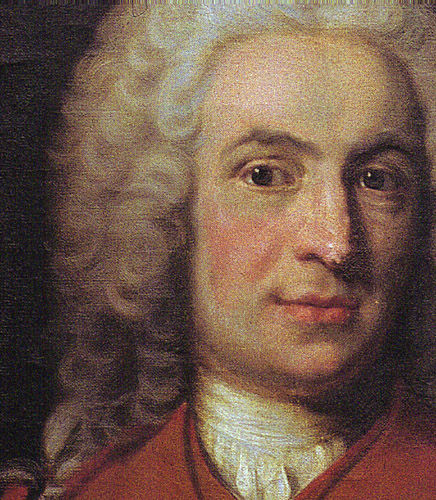
| | I den første tredjedel af 1700-tallet blev de sidste krige mellem nabolandene Sverige og Danmark-Norge afviklet. Krigene efterlod Øresundsregionen i stor armod, hvor en omfattende genopbygning blev nødvendig.
Det var også oplysningens tidsalder i Europa, hvor de enevældige despoter var tvunget til at være lydhøre over for kravene om ændringerne i produktion og produktionsforhold.
Den svenske videnskabsmand Linné foretog bl.a. sin skånske rejse i 1749 og dokumenterede her dele af Øresundsregionens tilstand og anbefalede, hvad man burde gøre ved det.
På begge sider af Øresund finder samtidig en tidlig industrialisering sted og Nordsjælland spiller en central rolle i den tidlige romantiske digtning. |
De mange krige i 1600 og starten af 1700-tallet medførte store ødelæggelser i Øresundsregionen, sidst i forbindelse med Den store nordiske krig 1709-20. Oveni krig og ulykke kom også perioder med misvækst og en generel økologisk krise med nedslidning af ressourcegrundlaget, som følge af overforbrug og udpining af jorden.
Skåne, der tidligere fremstod som et rigt landskab, er på mange måder ødelagt og nedslidt og på Sjælland står det ikke bedre til: Skovene er for en stor del forsvundet, sandflugt hærger og ødegårde breder sig.
1700-tallet er imidlertid også oplysningens tidsalder og bestræbelserne på at kortlægge natur og samfundsforhold og skabe rationelle forbedringer i økonomi og samfundsforhold er i højsædet. Reformiveren er stor og de oplyste enevældige stater er lydhøre overfor ny tiltag.
I sidste halvdel af 1700-tallet kommer der i Danmark en række skov- og landbrugsreformer, som alle tager udgangspunkt i eksperimenter på kongens jorder i Nordsjælland. Disse reformer får vidtrækkende betydning for samfundsudviklingen og forandrer kulturlandskabet radikalt.
I Skåne, hvor adelen står stærkt og der nu er langt til landets administrative centrum, kommer denne udvikling noget senere. Botanikeren og oplysningsmanden Linnés rundrejse i Skåne i året 1749 vidner om stor reformiver og i slutningen af århundredet er der klare tegn på vækst i bysamfundene, specielt Landskrona og Malmö. Landbrugsreformer i Skåne kommer først for alvor i starten af 1800-tallet og i modsætning til i Nordsjælland går det ikke stille for sig, men fører til regulære bondeoprør.
En tidlig industrialisering finder sted på begge sider af Øresund. I Höganes udvikles med udgangspunkt i lokale forekomster af råvarer, kul og ler, en omfattende produktion, der i tid går langt forud for den senere industrialisering i landskabet.
I Hellebæk på sjællandssiden har man siden 1500-tallet udnyttet de lokale vandkraftressourcer og i 1700-tallet udvikles på privat initiativ fabrikation af geværer til den danske stat. Produktionen er fortsat håndværkspræget og markedet er forholdsvis lukket, men det peger frem imod den begyndende industrialisering og urbanisering som kan iagttages i Helsingør i slutningen af 1700-tallet.Store Nordiske Krig
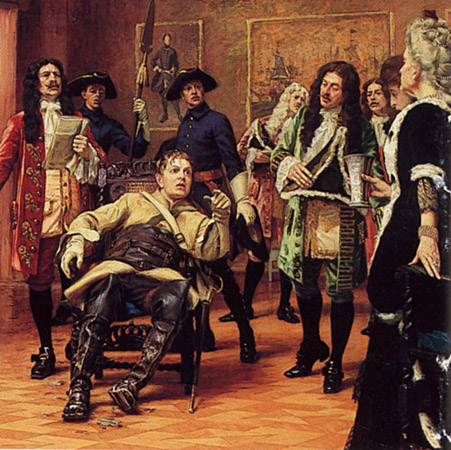
| | Store Nordiske Krig er en samlet betegnelse for en række krige som en alliance af flere lande, heriblandt Danmark, førte mod Sveriges erobringspolitik i perioden 1700-1721.
Danmark fik ikke sine tabte områder tilbage, men Sverige måtte opgive sin toldfrihed i Sundet.
Under Store nordiske Krig blev både Sverige og Danmark hærget af en omfattende pestepidemi. |
Anti-svensk alliance
Den unge svenske konge Karl 12., som efterfulgte sin far Karl 11., havde fået en alliance af stater imod sig, som alle krævede revanche efter Sveriges erobringer i 1600-tallet. I denne alliance indgik Danmark, Rusland og Sachsen(inklusive Polen). På dette tidspunkt var Sverige imidlertid godt rustet. En ny orlogshavn var opbygget i Karlskrona af Karl 11., som også havde reformeret forsvaret, som på dette tidspunkt bestod af 65.000 mand og 38 linieskibe. Endelig havde den nye grænse mod Danmark ved Øresund fået en del nye fæstningsanlæg.
1700-tallets historie i Øresundsregionen indledes så at sige med en krigshandling, idet en svensk hær under Karl 12,s ledelse samme år overføres fra Helsingborg og Landskrona til Humlebæk på Sjælland. København blev truet og Danmark blev tvunget til separatfred.
Efter separatfreden med Danmark fortsatte Karl 12.sit krigstogt mod Rusland og Polen og kom med sin hær langt ned i Østeuropa, men da den svenske krigslykke vendte i slaget ved Poltava (1709) erklærede Danmark krig imod Sverige. Den danske hovedstyrke, som til slut omfattede 14.000 mand, landsteg ved Rå i november 1709.

Karl 12. | 
Svenskernes landgang ved Humlebæk | 
Bombardementet af København |
Helsingborg indtages
Helsingborg forsvarede sig med en garnison på 36,mand og en svensk enhed på 1500 mand befandt sig i området ved Rå. Disse kunne givetvis ikke forsvare byen og trak sig tilbage. Frederik 4. indrettede sit hovedkvarter i rådmand Schlyters gård i det centrale Helsingborg og dens borgere svor troskab imod den danske konge. I Helsingborg indførtes dansk gudstjeneste og dansk almanak ifølge den gregorianske tidsregning, mens det øvrige Sverige stadigvæk fulgte den gamle julianske kalender. Det indebar en forskel på ti dage.

Herman Schlyters hus i Helsingborg |
Stenbock til Helsingborg
Den svenske konge befandt sig langt borte fra sit hjemland, så det svenske forsvar organiseredes af Magnus Stenbock, som var Skånes generalguvernør dvs. landshøvding og krigsleder. Han samlede en stor arme i Småland, eftersom danskerne var trængte ind i Sverige helt over til Karlshamn i Blekinge. Det lykkedes Stenbock at skrabe 16.000 mand sammen, som gik ind i Skåne i slutningen af januar 1710. Danskerne trak sig tilbage mod Helsingborg og tog opstilling nord for byen under generalmajor Rantzaus ledelse.
28. februar 1710 stødte de to hær sammen i slaget ved Ringstorp udenfor Helsingborg og det hele endte med en knusende svensk sejr, som Stenbocks kurer, Henrik Hammarberg, kunne rapportere til Stockholm.

Stenbock, Magnus | 
Budskab om Magnus Stenbocks sejr | 
Mindesten for slaget ved Helsingborg | 
Befæstning af den svenske kyst | 
Helsingborg 2010 |
Dansk Tilbagetog
I Helsingborg organiseredes og gennemførtes derefter en udskibning af danske soldater og danske sympatisører tilbage til Danmark, deriblandt rådmand Herman Schlyter og sognepræsten Hans Jacobsen, som begge havde samarbejdet med danskerne. I sammenhæng med flugten over Øresund blev alle heste dræbt, hvilket vanskeliggjorde arbejdet med at få byen til at fungere igen. Sandheden er at Helsingborg ikke kom sig førend 100 år senere. Det var sidste gang danskerne forlod Skåne efter et krigsforetagende.
Karl 12. vender hjem
Grænsen imellem Danmark og Sverige var nu definitivt fastlagt. Den svenske konge vendte tilbage til Sverige i 1715 efter sit til slut mislykkede felttog i Østeuropa. Han styrede Sverige fra Lund, hvor han i 1715-18 havde sit hovedkvarter. Ved den tid havde regeringen ladet opføre skanser ud imod Øresundskysten for at forhindre ny danske landstigningsforsøg. Resterne af disse skanser kan i dag beses ved f.eks. Barsebäck, Rå og Mølle.
Karl 12. gjorde et sidste forsøg på at styrke Sveriges udenrigspolitiske stilling ved et angreb på Norge1718, men han blev dræbt I en løbegrav udenfor fæstningen Fredriksten. Nu begyndte Sverige at søge fred og Norden havde ingen stormagt længere. Fra tidligere at være en vigtig samfærdselsvej var Øresund nu forvandlet til en grænse, hvor Danmark og Sverige vogtede på hinanden.
Misvækst og hungersnød
Sverige oplever under krigen to misvækstperioder i 1709-10 og igen fra 1716-18, hvor der var hungesnød og man må blande bark og andre ting i brødet. Botanikeren Carl von Linné giver i et efterladt skrift fra kriseårende anvisninger på 29 forskellige vækster som man kan strække melet med, f.eks. hedder det om mælkebøtten:
”Af denne kan bladene spises som kål og roden tørres til brød, ihvervel den frisk har en noget besk smag, som dog i tør tilstand mere og mere forgår”
Pestens gerninger
Under Stor nordiske Krig hærges både Sverige og Danmark af en omfattende pestepidemi, som kommer til Østersøområdet med en svensk hærafdeling som simpelthen blev kaldt pesthæren.
I 1710 kommer pesten til Stockholm og omtrent samtidig når den til Øresundsregionen, hvor den spredes til begge sider af Sundet. Selvom danskerne på dette tidspunkt for nylig har forladt Helsingborg er samkvemmet ikke ophørt. Pesten spredes således i foråret 1711 fra Helsingør til en række fiskerlejer på den anden side af Sundet: Først Domsten nord for Helsingborg, siden hen Viken, Höganes, Mölle og Arild. Omkring 2/3 del af befolkningen i disse fiskelejer falder bort.
Pesten i Helsingør 1709-11
I august måned 1709 modtager Helsingør by fra Politi- og Commercekollegiet underretning om, at en smitsom epidemi er brudt ud i Danzig og forskellige foranstaltninger iværksættes, bl.a. at skibe fra Danzig ikke måtte komme nærmere byen end et bøsseskud. De blev modtaget i åben sø af en båd med en mand som skulle modtage papirer, der siden hen skulle destrueres.
August måned året efter ophæves foranstaltningerne mod skibe fra Danzig, men straks efter erklæres stor dele af Nordtyskland og Baltikum for smittede og i januar måned 1711 begynder man også at træffe lokale foranstaltninger på baggrund af et stigende antal dødsfald på Lappen, som man dog ikke med sikkerhed kunne tilskrive en smitsom epidemi. Det beordres fra centralt hold, at de præster og barberer, der tager sig af de syge på Lappen, skal skifte tøj førend de skal omgås andre og byens magistrat befaler,
"... at de Syges Qvæg ej maatte søge Græsgang med de karske Borgeres, samt at Hunde og Katte, der løbe fra Hus til Hus og letteligen bringe Smitten omkring, skulle dræbes, ligesom Høns og Ænder, men især Duer, strax slagtes".

Gravsten. Skt. Olai kirke, Helsingør |
Tabstallene
I de efterfølgende måneder huserer epidemien, men på et kontrollabelt niveau og først i maj måned antager den et omfang, der fører til, at det under livsstraf forbydes at rejse fra Helsingør til København. Den 25. maj bliver byen afspærret med militær i en linie fra Egebæksvang i syd over Mørdrup og Nyrop til Villingebæk i nord. Sygdommen, antagelig en byldepest, kulminerer i august måned, hvor der i Sct. Olai menighed dør 100 mennesker i Sct. Marie 31. Tilsammen omkommer ifølge præsternes indberetninger til magistraten i året 1711 1809 personer, omtrent en tredjedel af byens befolkning. Først d.25.juni 1712 åbnes der igen for fri passage til byen.
Trods omfattende karantæneforanstaltninger, formår pesten alligevel at sprede sig til hovedstaden og det anslås at i alt omkring 40.000 personer dør i København og Nordsjælland som følge af pestepidemien. Statistisk materiale giver anledning til nogle interessante betragtninger om sammenhængen imellem dødsfald og befolkningens evne og lyst til at regenerere. Det viser sig her at antallet af ægteskaber i Helsingør stiger markant i tidsrummet efter den store pestepidemi. Den enes død, den andens brød.Kongernes Nordsjælland
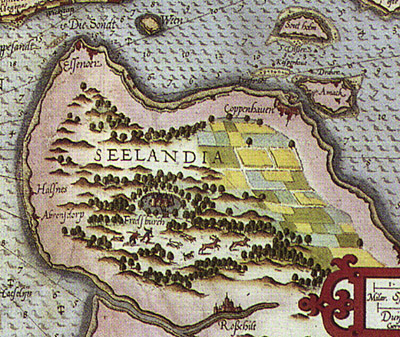
| | I starten af 1700-tallet ejede den danske kongemagt det meste af Nordsjælland, som fortrinsvis blev benyttet til jagtterræn og hesteopdræt.
I det naturskønne område blev der opført lystslotte med tilgrænsende haver i tidens barokstil.
|
Jagt
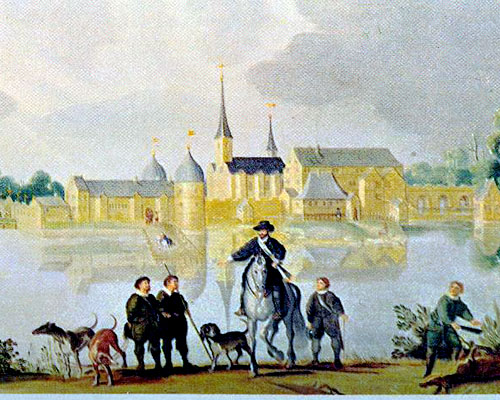
| | I starten af 1700-tallet ejer kongen det meste af Nordsjælland, som fortrinsvis benyttes til jagtterræn og hesteopdræt. |
Kongens domæne
Efter reformationen i 1536 overtager kongemagten omfattende jordbesiddelser fra klostrene i Nordsjælland og i tiden herefter øges kronens jordejendom i området yderligere. Omkring 1546 køber kongen således 64 selvejerbønder ud og ved jordbytte med adelen lykkes det i anden halvdel af 1500-tallet kongemagten at skabe rådighed over det meste af Nordøstsjælland.
Kongens hovedinteresse i Nordsjælland var jagten, og størstedelen af landskabet benyttes som jagtterræn og græsningsarealer for kongens heste. Det dyrkede areal var derfor sparsomt og kronbøndernes hoveriarbejde bestod hovedsagelig i høslet, træfældning og ikke at forglemme bygge- og anlægsopgaver. I Frederik II.s tid opføres således Kronborg og Frederiksborg Slot og i 1584 anlægges den første såkaldte kongevej som forbandt de to slotte.

Nordsjælland | 
Kongens jord | 
Det første Frederiksborg | 
Kongevej i Nyrup Hegn | 
Kongeveje i Nordsjælland |
Vildtbaner og dyrehaver
I Frederikd.2.s tid påbegyndes arbejde med at indrette vildtbaner og afspærrede dyrehaver, f.eks. Lille Dyrehave, der omgav selve Frederiksborg Slot. Christian 4., der i sin tid ombygger Frederiksborg Slot, fortsætter arbejdet med at forbedre jagtterrænet med anlæggelsen af Store Dyrehave syd for Hillerød, som indhegnes med røde stakitter. Han udbygger ligeledes kongevejene sydover, så han kan komme hurtigt frem og tilbage imellem Frederiksborg og den voksende residensstad København.
Christian d. 5.(1670-1699)havde som kronprins i 1662-63 gæstet den franske solkonge Ludvig d.14.s hof og her stiftet bekendtskab med parforcejagten og ønskede nu at skabe betingelser for at bedrive denne jagtform i Nordsjælland. 1669 påbegyndes anlægget af den senere Jægersborg Dyrehave, som i 1670 udvides af Christian 5. til også at omfatte det nuværende Jægersborg Hegn. En engelsk parforce-jæger, Robert Badge, indkaldes og allerede i efteråret 1670 drives parforcejagt med engelske hunde, heste og jægere.

Lille Dyrehave | 
Store Dyrehave | 
Frederiksborg 1652 |
Jægersborg og Frederiksborg
I 1680, efter afslutningen af Skånske Krig, påbegynder kong Christian 5. en samlet reorganisering af jagtterrænet. Han indkalder to eksperter fra England og fra omkring år 1700 foreligger der planer over de allerede påbegyndte anlæg omkring Frederiksborg Slot og den sydlige del af Esrum sø. Jægerborg bliver, som navnet antyder, centrum for administration af jagten, men selve jagten foregår i hele Nordøstsjælland. Kongen bedrev alle mulige andre former for jagt, oprettede et falkoneri og arrangerede dyrekampe. I Lille Dyrehave ved Frederiksborg var der således løver, elefanter og rensdyr og i slottets værelser fugle og aber sammen med yndlingshundene.
Ofte tog jagten udgangspunkt fra Frederiksborg Slot, men der var også en jægergård i Nyrup udenfor Helsingør og kongen holdt også til på Østrup, hvor Fredensborg nu ligger. Jagten var som oftest et omfattende foretagende, som krævede store ressourcer. Til en klapjagt på Jægerspris i 1680 skulle 500 mand møde som klappere og medbringe kost til 5-6 dage.
Parforcejagten
Parforcejagt foregik til hest, hvor jægerne ad de anlagte stier jagtede et stykke vildt med hunde, som sluttelig stillede vildtet, så kongen eller en af ham udpeget kunne få fornøjelsen af at aflive dyret med kniv (hirschfänger). Ømosen i nærheden af Gurre var et fast tilholdssted for de store hjorte og ofte udvalgte kongen her det pågældende dyr. 1720 var der 140 hunde og 50 hvalpe knyttet til parforcejagten. Jagthundene skulle indøves og det forgik på Jægergården i Nyrup.
Jagten varede som oftest flere timer og havde karakter af selskabelig begivenhed, hvor damerne fra åbne vogne, eller pavilloner kunne iagttage skuespillet med den enevældige monark som hovedrolleindehaver. Den englelske iagttager Robert Molesworth har beskrevet afslutningen på en jagt i Christian 5.s tid.

Parforcejagt | 
Parforcejagt | 
Parforcejagt |
Hoffets vildtforbrug
Normalt gik alt vildtet fra de kongelige jagtrevirer til den kongelige husholdning og hoffets vildtforbrug var stort. I 1680 anvendtes 56 retter vildt om ugen.Stutteri
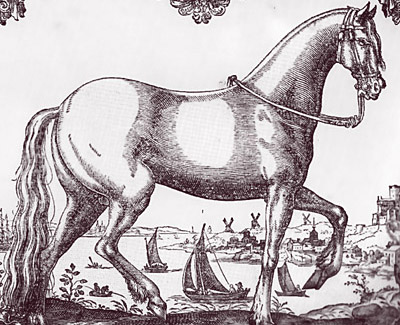
| | Frederiksborghesten regnedes i samtiden for en af i alt seks forædlede europæiske hesteracer. Med tiden avledes ensartet farvede heste i undergrupper, således at kongen kunne anvende typisk et seksspand af ensartede heste for en vogn, eller forære det som gave til andre kongelige. Frederiksborghesten på dette stik befinder sig pudsigt nok på Skånekysten med Kronborg i baggrunden. |
Frederiksborgstutteriet
Allerede fra tidlig middelalder er der vidnesbyrd om hesteopdræt- og eksport fra det danske område. Abbed Wilhelm af Æbelholt modtager således et takkebrev for en pragtfuld hest han har skænket abbed Stephan i Paris. En anden kilde fra omkring 1200 omtaler årlig eksport fra Ribe alene på 8000 heste og krønikeskriveren Arnold fra Lübeck beretter at landets rigdomskilde er hesteavlen.
Igennem hele middelalderen har hesten været uundværlig som kommunikationsmiddel: til transport, som arbejdsredskab og i krig. Behovet for og forbruget af heste har været enormt og ridderen til hest bliver nærmest et ikon på middelalderen. I dansk sammenhæng er der kendskab til at kong Erik Menved, ved en fyrstefest udenfor Rostock i 1311, forærer mere end 80 mænd ”en pasgænger til hver”, altså hver en hest, med tilbehør og klædning i forbindelse med at de slås til riddere.
Koncentration i Nordsjælland
Hesteopdræt i middelalderen, hvor kongen varetog sine administrative pligter ved rundrejser i riget, har fundet sted på adskillige af de kongelige ejendomme,, men også på adelens og klostrenes jorder. Med reformationen i 1536 overtager kongemagten klosterjorden og ved at bytte jord med adelen samler kronen efterhånden det meste af jordejendommen i Nordøstsjælland. Hensigten er bl.a. at skabe sammenhængende jagtarealer og at fremme hesteavlen.
I Christian 3.s tid opkøbes frisiske heste til stutterivange ved Esrum Sø og Frederik 2.interesserer sig allerede ved sin tronbestigelse i 1559 for hesteavlen. I 1560 forlader de sidste munke Esrum Kloster og kongen indforskriver samme år heste fra Nyborg Slot til Frederiksborg, hvor der i 1562 oprettes stutteriet. Fra d.5.april 1584 stammer følgende kongelige befaling:
”Kongen har truffet foranstaltning til at folene på Faurholm kunne blive hentede derfra; den grå tyrkiske hest, som kongen har fået af kongen af Polen, skal han lade komme til det ungerske stod på Fauerholm.”

Frederik 2. hyldes 1559 | 
Ridderturnering | 
Slottet Sparepenge | 
Esrum Kloster | 
Det første Frederiksborg |
Renæssancens heste
Ejendommen Fauerholm havde Frederik d. 2. byttet med adelsmanden Peder Oxe som i stedet fik Tølløse på Midtsjælland. Af et brev fra den efterfølgende dag fremgår det endvidere at der også var hestestod ved både Esrum og Hørsholm og at disse bl.a. rummede kraftige heste af frisisk karakter. Disse heste anvendtes fortrinsvis som køreheste. Tilsyneladende var kongen i besiddelse af både tyrkiske(arabiske) og ungarske heste og han importerede også heste fra Italien og Spanien for at udvikle avlen.
Tiden stiller nye krav til hestenes udseende og anvendelse, både militært og civilt. Kongemagten bliver mere bofast og hestene anvendes nu i stigende grad i repræsentative sammenhænge. Allerede i Frederik 2.s tid bliver den danske hest berømt ude omkring i Europa. Den ærkekatolske spanske regent Philip d.2. bestiller således i 1583 60 hopper med henblik på avl og den franske konge rekvirerer et lignende antal. Man må forestille sig prototypen som en robust og alsidig hest, som egner sig som både ride- og kørehest.

Fauerholm |
Christian 4.s tid
Christian 4. ombygger det første Frederiksborg og ved lystslottet Sparepenge opføres i 1599 en stald til 300 heste. Der indføres brændemærkning af hestene og i 1610 bliver Esrum, som hovedsagelig var en græsgård, hovedsæde for stutteriet. Et tilsvarende anlæg planlægges ved Börringe Kloster i Skåne.
I sammenhæng denne omlægning nedlægges en række landsbyer langs Esrum Sø, jorden udlægges til stutterivange(kobler) og der opføres og udbedres diger og grøfter. Der var desuden to stod ved selve Frederiksborg, hvor også tilridningen af hestene foregik. Den danske hest, Der Dänen Ross, beskrives i 1610 som en af seks forædlede europæiske hesteracer. Fortsat en robust hest med barokhestens betydelige tyngde, som det bl.a. fremgår af rytterportrætter af Christian 4.

Frederiksborghesten | 
Christian 4. til hest | 
Frederiksborg 1652 | 
Rideskolen |
Krigens betydning.
Svenskekrigene med besættelse og plyndringer i tiden 1657-1660 gik hårdt ud over stutteriet. En del heste tog svenskerne som krigsbytte, andre løb forvildede rundt i skovene og det var vanskeligt at få overblik over situationen. Det hedder herom i en skrivelse fra 1661.
”Udi Kronborg Len er ingen Ladegård uden Esrom, hvorpaa holdes kongl. Majestæts Stutteri. Ellers ligger her under Slottet trende Engvange, Gurre Vang, Teglstrup Vang og Egebæks Vang”
Kronborg Amt udgjorde den nordlige del af det nuværende Frederiksborg Amt, Frederiksborg Amt den sydlige del. Esrum er altså fortsæt centrum for Stutteriet, mens de nævnte engvange fortrinsvis anvendes til høslet. Efter høhøsten lod man som oftest hopper med føl afgræsse engene.

Hestehavehus |
Enevælde og barokheste
Christian 5.(1670-1699) havde som kronprins besøgt Ludvig d.14.s hof og der studeret enevældens pragtudfoldelse på nærmeste hold. Allerede i 1670 tager han initiativ til indførelse af tidens jagtmode, parforcejagten, indkalder dertil engelske rådgivere og indfører engelske heste til brug herfor.
I løbet af nogle årtier er stutteriet tilsyneladende kommet på fode igen efter svenskekrigene. Herom vidner bl.a. den medgift som kong Christian 5. giver sin søster, Ulrikke Eleonora, da hun i 1679, efter Skånske Krigs ophør, skal giftes med den svenske kong Carl d.11. Prinsessen forsynes med ikke mindre end 7 forspand med 6-7 heste i ensartede farver, og så det løse.

Dressurridning | 
Christian 5 | 
Rød ridedragt | 
Ridedragt 2 | 
Ridedragt 3 |
Et væddeløb
Om hestenes anvendelse og færdigheder fortæller også et berømt væddemål imellem den engelske gesandt Robert Molesworth og kongens overstaldmester, Anton Wolff baron von Haxthausen. De to vædder 1000 hollandske dukater, en ganske betydelig sum, om, hvorvidt en af kongens heste kunne løbe distancen fra Nørreport i København til byporten i Hillerød, i alt 35 kilometer på under 45 minutter.
Molesworth fik lov at vælge frit imellem fem rideheste i den kongelige stald og valgte en lille tigret(plettet) hest, som 14 dage senere gennemførte ridtet på 42 minutter, altså under den fastsatte tid. Der var her tale om en såkaldt Coureur(løber), som måske anvendtes specielt til parforcejagten Ifølge overleveringen findes den pågældende hest udstoppet på Christiansborg Ridebanemuseum

Robert Molesworth | 
Udstoppet hest |
Rideopvisninger
Hestevæddeløb var ikke en almindelig foreteelse på dette tidspunkt. Offentlig optræden var begrænset til repræsentative sammenhænge, f.eks. bryllup og begravelser, men for hoffet og indbudte gæster var der også indendørs optræden i f.eks. Christiansborg Ridehal. Ridebanen udenfor kunne naturligvis også benyttes og rundt omkring i København fandtes andre egnede arealer. Christian 5. foretræk efter sigende et areal i Rosenborg Have, men f.eks. var Kongens Bytorv, hvor Christian 5.s rytterstatue nu står, oprindelig planlagt som ridebane.
Ved de store hoffester optrådte kongen selv med andre i turneringer med ringridning og fingerede bataljer med kostbare præmier til vinderne. En øjenvidneskildring af festligheden ved Ulrikke Eleonoras forstående bryllup i 1680 beretter udførligt om en sådan optræden på Christiansborg Rideplads d. 11.april. Efter optræden med ringridning og hesteballet afsluttes med en tredje halvleg med dyrekampe imellem hunde og bjørne, tigre, grævlinger og tyre.

Prins Jørgen i trav | 
Prins Jørgen på Pompeux | 
Hesteballet | 
Rosenborgtapetet | 
Det oprindelige Christiansborg |
Den Høje Skole
Christian 5. var selv var en fortrinlig rytter, der efter sigende kunne ride 6 heste trætte på en formiddag. Det handler i den daglige træning om dressur, forskellige gangarter og spring, efter den såkaldte Høje Skoles principper. Alle disse gangarter og spring er udførligt skildret på en række malerier fra 1690erne, udført af en ukendt kunstner op ophæng på Rosenborg Slot.
Her kan man iagttage de forskellige gangarter, volter og spring, som egentlig stammer fra krigskunstens brug af hesten. Halvdelen af de 24 malerier skildrer dette, mens den anden halvdel viser scener af de såkaldte ridekarousseller optræden med ringridning med videre. De afbildede heste har, som den nuværende lippizanerhest, typisk barokhestens kendetegn,: Krumnæset hoved, svær, tykstrubet hals, lang ryg og muskuløst kryds. Billederne er efter tidens mode noget fortegnede, men viser også nogle af kendetegnene for den senere Frederiksborghest.

Dressurridning | 
Prins Jørgen i trav | 
Prins Jørgen på Pompeux | 
Krindsen | 
Ringridningsgitter |
Renavlen
I 1690 udsendes en stutteriordning, hvorved der indføres nye principper med såkaldt renavl efter farve, dvs. man oparbejdede enheder (stod) med ensartede heste, røde, hvide heste osv., således at kongen kunne råde over adskillige forskelligartede spand til sine mange officielle gøremål. Renavl efter farve betegner et skift i moden som har været undervejs i flere årtier, men som nu også bliver toneangivende i rokokotidens smag og retningsgivende for avlen ind i 1700-tallet.
Der indkøbes et stort antal især spanske hingste for at fremme bestræbelsen på renavl og i første omgang med gode resultater.

Heste foran Christiansstad | 
Mangefarvede heste | 
Bella og Hertha | 
Hingsten Hother |
Ryttergods og stutterier
Omkring 1700 indføres en ordning med såkaldt ryttergods, hvor en kavalerist forsynes med et lille jordlod og en hest han skulle stille med i krigstid. Krongods udlægges til formålet og kongens stutterivirksomhed leverer hestene. I 1717 overgår Esrum Kloster til ryttergods og en stor del af jorden udlægges hertil. Samme år flyttes centrum for avlsarbejdet tilbage til Frederiksborg Slot og i 1720 gøres Lille Ladegård ved Frederiksborg Slot til nyt centrum for stutteriet.
Et kort fra omkring 1720 viser stutterivangenes beliggenhed i sammenhæng med ryttergodset. Det viser et udstrakt foretagende med centrum omkring Grib Skov og Esrum Sø. Arealerne, vangene, var spredt udover hele Nordsjælland, fra Egebæksvang i øst til Pandehave Hestehave i nord. Mange stednavne i Nordsjælland, f.eks. og Hestehave ved Hillerød, Søborg Hestehave, og en lang række lokaliteter i Grib Skov med endelsen –vang, vidner fortsat om stutteriets aktiviteter.

Stutterivange 1720 | 
Stutteriet ved Frederiksborg | 
Græssende heste |
Stutteriets storhedstid
Første del af 1700-tallet betegner Frederiksborgstutteriets storhedstid og det bliver landets største landbrugsenhed med samlede tilliggender op på 11.300 tønder land, 100 fastansatte personaler og efterhånden op imod 1600 heste. Det bliver imidlertid også begyndelsen til enden. Princippet med renavl efter farver rummede stor risiko for indavl og dette bliver med tiden stadig mere tydeligt. Desuden var forbruget af heste enormt og det var forbundet med stor prestige for kongemagten at anvende de ensfarvede heste som gaver til andre kongelige.
Da Frederik 4.(1699-1730) i 1708 begiver sig på rejse ned i Europa medbringer han således to hvide hingstespænd fra Krogdalsvangen, som han forærer bort undervejs. Nogle år løb foræringernes antal op på 150 individer og medførte at man måtte opkøbe nye og andre heste til stutteriet. Da samme Frederik 4. i 1730 begraves anvendes ikke mindre end 120 helt sorte heste i forbindelse med ligtoget fra København til Roskilde.

Krogsdalsvang | 
Vangesten |
Fortsat udvidelse
Frem til omkring 1740 er hestene vinteropstaldet rundt omkring på de kongelige ladegårde, men i perioden 1742-46 opfører arkitekten Laurits de Thurah et samlet stutterikompleks kaldet Frederiksborg Ladegård. Omkring samme tidspunkt påbegynder billedhuggeren Saly en rytterstatue, der siden hen er berømmet som en af verdens bedste, og bliver selve symbolet på Frederiksborghesten. 22 år tog der Saly at færdiggøre statuen, der var skænket af Asiatisk Kompagni, som nærmest blev ruineret af projektet.
Et kort fra 1765 viser stutteriets udstrækning i Frederiksborg Amt. Her ser man stutteriets kerneområder bestående af en række vange omkring Esrum Søs vestbred, et lignende område selve Frederiksborg og endelig Store Dyrehave med tilliggende arealer. Fra dette tidspunkt stammer også en beretning om vangenes tilstand og anvendelse.

Frederiksborgstutteriet 1753 | 
Ladegården | 
Statuen på Amalienborg | 
Stutterivangene 1765. |
Nye toner
I de efterfølgende år kommer stutteriet i regulær krise, bl.a. på grund af indavl, og under Struenses regime 1771-73 begynder man at indskrænke virksomheden. Den engelskfødte dronning og Struenses elskerinde, Caroline Mathilde, er måske den sidste dronning der får hestehold i stor målestok til eget personlige brug: 2 rideheste og 31 køreheste.
Oplysningstidens nyttebetragtninger begynder nu at vinde indflydelse og for at rette op på økonomien beslutter man at sælge heste fra. Det sker på en auktion på Christiansborg og bliver et tilløbsstykke fra hele Europa. En af de frasolgte hvide hingste, Pluto, bliver en af stamfædrene til de berømte Lippizanerheste, en hoppe stammoder til den russiske Orloff-traver.
Bortsalget stopper imidlertid ikke tilbagegangen i avlen. Forsøg med avl på tværs af de enkelte stod fra omkring 1776 giver nogle positive resultater, mens eksperimenter med at hærde hestene, bl.a. ved udsætning af Fanestoddet fra Pibervangen på Hesselø i 1784, får katastrofale følger. I 1790 bliver det kongelige stutteri lagt sammen med landstutterivæsenet og skal nu i oplysningstidens ånd også medvirke til at ophjælpe bøndernes hestestammer. Et kort fra 1792 viser at stutterivangene på Cronborg Amt endnu på dette tidspunkt optager store dele af Grib Skov.

Stutterivange 1792 | 
Strøgårdsvang | 
Høsletseng |
Den store reduktion
Trods store vanskeligheder og omkostninger fremstår Frederiksborgshesten efterhånden som et nationalsymbol og først i 1799 indskrænkes stutterivirksomheden for alvor. I 1799 finder så den såkaldt store reduktion sted. 1170 tdr. land afgives til den nyoprettede avlsgård Fauerholm og de fem oprindelige stutterivange langs Esrum Sø overgår til Skoven. Skov- og landbrugsreformerne i slutningen af 1700-tallet har da allerede grebet dybt ind i stutteriets driftsform. Agerjorden er blevet udskiftet, noget heraf udstykket til husmandsbrug, men først i 1840 afløses de sidste rester af høsletshoveriet, bøndernes pligtarbejde for stutteriet.Fredensborg Slot
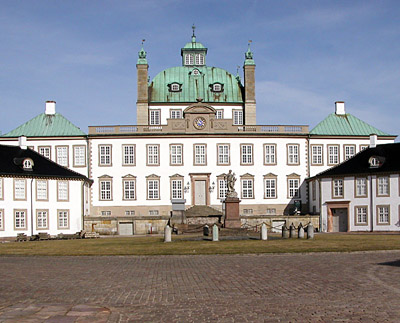
| | Efter afslutningen på Den store Nordiske Krig i 1720 synes man i Danmark endeligt at have opgivet tanken om at få Skånelandene tilbage. I hvert fald er fredstrangen så stor at kongen ved anlæggelse af en ny residensbolig mellem Frederiksborg og Kronborg vælger at kalde denne for Fredensborg og ifølge overleveringen var det de penge, der var afsat til krigen, som anvendtes til byggeriet. |
Europas stormagter dominerer
Ved fredslutningen efter Den store Nordiske krig i 1720 var de to dobbeltriger Danmark-Norge og Sverige-Finland vel stort set jævnbyrdige, men også reduceret til brikker i er internationalt spil, der var domineret af de europæiske stormagter Frankrig, England, Holland og efterhånden også Rusland og det tyske område (Preussen), hvor samlingsbestræbelser tager fart i løbet af 1700-tallet.
Fredensborg: Et fredssymbol
I Danmark synes man efter Den store nordiske Krig endelig at opgive tanken om at få Skånelandene tilbage igen. I hvert fald er fredstrangen så stor at kongen ved anlæggelse af en ny residensbolig mellem Frederiksborg og Kronborg vælger at kalde denne for Fredensborg og ifølge overleveringen var det de penge, der var afsat til krigen, som anvendtes til byggeriet.
Hvor Fredensborg Slot nu ligger lå tidligere en jagtejendom eller lystgård med navnet Østrupgård, hvor kong Frederik 4.. gerne tilbragte tiden i stedet for det prangende Frederiksborg Slot. I 1719, da man efterhånden kunne skimte afslutningen på Store nordiske Krig, lader kongen bygge en kalkovn, ryddede veje og skove som forberedelse til en nyopførelse på stedet. Allerede i 1722 står hovedbygningen færdig og nybygningen får navnet Fredensborg, hvilket henviser til fredslutningen efter den store krig. Oprindelig var det da også tanken at kuplens lanterne på hovedbygningen skulle have været en statue antagelig af fredsgudinden.

Fredensborg Slot | 
Set fra parken |
Barok med renssancepræg
Det oprindelige anlæg bestod af den anseelige hovedbygning med kuppelsal, som endvidere udgjorde den ene side i et ottekantet anlæg, som tillige med nogle fritliggende bygninger opføres under den senere landbygmester J. C. Krieger, som på daværende tidspunkt var gartner ved orangeriet i Rosenborg Have.
Forbilledet er måske den franske konges lystslot Marly, som kongen havde set på den første af sine udenlandsrejser i 1691-92. I det ydre har slottet imidlertid ikke meget til fælles med den overlæssede franske barokstil. Fredensborgs glatte murfacader genfindes på Frederiksberg Slot. Kun de brede vinduesindfatningerne med overliggende frontoner fungerer dekorativt, men de ligner mest af alt vinduesindfatningerne på Kronborg, som er i renæssancestil. Trods disse renæssanceindslag er hovedindtrykket dog iflg. "Slots- og Ejedomsstyrelsen", barok:
"Det smukke 1700-tals barokslot danner ofte rammen om større officielle statsbesøg og familiebegivenheder i kongefamilien."
Den tillempede renæssancestil er da også ganske særegen og har mest lighed med stilen på Stockholm Slot, der er opført af den berømte svenske arkitekt Nicodemus Tessin den yngre. Formodentlig er inspirationen gået via den senere landbygmester Johan Conrad Ernst, der i 1697 opholder sig hos Tessin i Stockholm for at sætte sig ind i konstruktionen af et residentsslot, som Christian d. 5. havde tænkt at opføre i Amalienborg Have i København. På denne måde er opførelsen af Fredensborg Slot et vidnesbyrd om den kulturelle udveksling imellem de to lande, som bestod på trods af krig og uenighed.

Det oprindelige udkast | 
Døre og vinduer |
Jardins indflydelse
Efter Fredensborgs opførelse i 1723 kommer snart alle betydelige arkitekter i århundredet i berøring med byggeriet i forbindelse med udvidelser og ændringer, som dog heldigvis ikke spolerer slottets oprindelige karakter. Sidst, men ikke mindst, er den franske arkitekt N.H. Jardin involveret i planer for en større ombygning af selve slottets hovedbygning og haven, som omlægges over en årrække fra 1759-68. Størstedelen af de øvrige projekter opgives da kongen omkring 1762 skal bruge flere penge på oprustning på grund af modsætningsforhold til Rusland.

Fredensborg 1729 | 
Jardins plan 1760 | 
Normandsdalen |
Barokhavernes tid
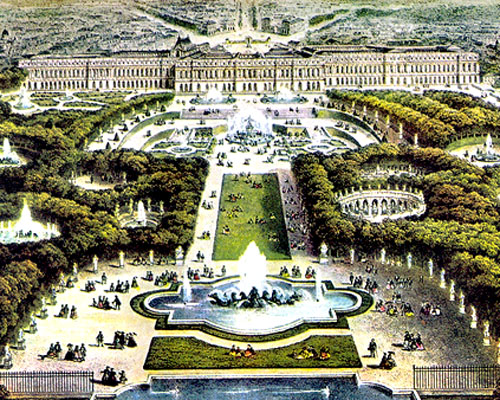
| | Europas enevældige konger blev i 1700-tallet inspireret af bl.a. Versailles i Frankrig og fik anlagt barokparker, der skulle markere magt og enevælde.
Eksempler på sådanne anlæg er Frederiksborg og Fredensborgs slotshaver samt Marienlyst i Helsingør. |
Frederik 4.s haver
Selve fredsslutningen efter Store nordiske Krig fandt sted på Frederiksborg Slot, hvor den danske konge, Frederik 4..(1699-1728), efter krigsafslutningen 1720 tog fat på at anlægge et omfattende haveanlæg med tilhørende vandkunst.
Ligesom sin far havde kong Frederik som kronprins i 1692-93 været på dannelsesrejse sydpå, gennem Tyskland til Italien og Frankrig, hvor han gæstede solkongen, Ludvig d.14.s hof. Mens Christian 5. hentede inspiration til fornyelse af jagt og hesteopdræt, var det der optog Frederik først og fremmest haveanlæg og gerne med indlagte springvand og kaskader. Dette havde han lejlighed til at iagttage bl.a. ved besøg i renæssancehaver i Norditalien og naturligvis også det imponerende barokanlæg ved Versailles-slottet udenfor Paris.

Versailles |
Frederiksborgs barokhave
Allerede i 1702 begyndte kongen at overveje at fjerne Sparepenge og den tilhørende have for at udnytte det skrå terræn på den anden side af slotssøen til anlæggelse af en større barokhave. 1720 begynder kongen at virkeliggøre sine planer. Sparepenge bliver brudt ned og en del af stenene herfra anvendes til opførelsen af Fredensborg Slot. I årene 1720-25 opføres den nye have efter plan af arkitekten Johan Cornelius Krieger.
Anlægget er på 100x 400 meter, anlagt i tre planer på det skrånende terræn. Venstre side af anlægget er koncentreret om en midterakse, der udgøres af en gennemgående vandkaskade. Anlægget omkring denne akse er symmetrisk beplantet, hvor de lave parterre-bede på første trin udgøres af varierede kongelige monogrammer.

Frederiksborg slotshave | 
Frederiksborg Slots omgivelser |
Havens ide
Anlæggets midterakse afsluttes med en obelisk der i samspil med den vertikale beplantning medvirker til at skabe et optisk bedrag, en fornemmelse af et næsten uendeligt anlæg. Hermed demonstrerer ophavsmanden sin evne til at beherske landskabet og naturen.
Endvidere forlænges den gennemgående akse naturligt over søen til selve slotsanlægget, den enevældige monarks bolig. Samlet er det et udtryk for monarkens kontrol over og beherskelse af natur og kultur i en samlet enhed. Beherskelsen kommer til udtryk ned i de mindste detaljer, gennem den velordnede symmetri og den sirlige klipning af beplantningen. Anlægget skal imponere beskueren og udtrykke den enevældige statsmagt formåen.
Fredensborg Slotshave
Fredensborgs Slots forgænger Østrup var en integreret del af kongens jagtanlæg, faktisk beliggende midt en af parforcejagtanlæggets stjerner, hvor en række anlagte vej mødtes. Dette blev også udgangspunkt for det haveanlæg, som arkitekt og bygmester Krieger tog fat på omkring 1722.
De af hensyn til jagten udhuggede veje i skovlandskabet blev nu omdannet til alleer, som samledes i centrum af hovedbygningens havestue. Tværgående veje blev tilføjet og inderst i denne halvcirkel blev anlagt en række parterre-bede i regelmæssige mønstre, formodentlig beplantet med takstræer, som var hentet fra Jægersborg. Mod vest anlagdes desuden en række firkantede parterre-bede, som bl.a. rummede kongelige monogrammer.
I tilknytning til anlægget skabtes såkaldte runde alleer, herunder den såkaldte Normandsdal, der opføres omkring 1760. Fra samme tidspunkt stammer en detaljeret plan for reorganisering af haven ved den franske arkitekt N.H. 191. I denne fremhæves en centralakse med udgangspunkt i den midterste alle, men de øvrige alleer bibeholdes og samlet dannes der et såkaldt gåsefodsmønster, som f.eks. også genfindes i Versailles-parkens barokke haveanlæg. Anlægget er således fortsat barokt i sin grundstruktur, men Normandsdalen med sandstensfigurer af norske og færøske godtfolk vidner om oplysningstidens interesse for kortlægning og registrering med udgangspunkt i Christian d.6.s Norgesrejse i 1733.

Fredensborg 1729 | 
Jardins plan 1760 | 
Normandsdalen | 
Nordmandsdalen |
Frederiksberg Have
Frederik 4.lod i starten af 1700-tallet også Frederiksberg Slot opføre i umiddelbar nærhed af residensbyen København. Formålet var bl.a. ar skabe et nærrekreativt område for hoffet og til dette hørte naturligvis også en have. Fra omkring 1760 stammer en plan som viser er typisk barokanlæg med et strengt symmetrisk anlæg både foran og bagved hovedbygningen i det nuværende Søndermarken på den anden side af Roskildevej.

Frederiksberg Slot | 
Frederiksberg Have |
Marienlyst Slot og barokhave
Den franske arkitekt Nicholas-Henri Jardin kom oprindelig til Danmark for at udbygge den såkaldte Frederiksstad i midten af København. Planerne herfor blev imidlertid aldrig til noget, men i stedet kom Jardin til at virke i forbindelse med Fredensborg nye haveanlæg omkring 1760 og arbejdede samtidig med en ombygning af det gamle lysthus Lundehave udenfor Helsingør. Jardin valgte at bibeholde det gamle Lundehave som et fremspringende midterparti i en tredelt bygning i klassicistisk stil.
Hermed fik Danmark et tidligt og vellykket bygningsværk i en ny tids stilart. Barokstilen er ved at tone ud, men det iagttages endnu i det tilhørende haveanlæg, der fortsat er strengt symmetrisk anlagt i den barokke, franske havestil.

Marienlyst Slot i Helsingør | 
Moltkes Haveanlæg | 
Marienlyst med have. |
Linnés skånske rejse 1749
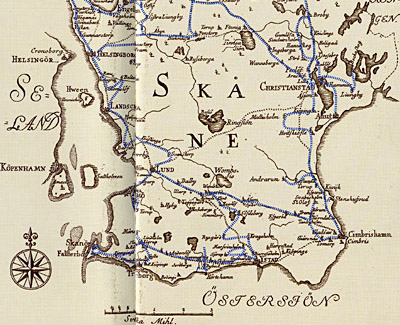
| | Den verdensberømte svenske videnskabsmand, botanikeren Linné, foretog i 1700-tallet en rejse igennem Skåne, hvor han rapporterede til den svenske regering om regionens forsømte tilstand og gav detaljerede forslag til ændringer af de bestående, elendige, forhold. Rapporten er en fremragende førstehånds og primær kilde til datidens Skånes landskabsmæssige forhold og folkelige traditioner. Men også til oplysningstidens videnskabsmænds måde at tænke på.
På kortet ser man Linnés rejserute markeret på et kort over Skåne. |
Linnés skånske rejse 1749
En præstesøn fra Småland, i fuld gang med en usædvanlig videnskabelig karriere i Uppsala, kom i 1749 til Skåne. Denne Carl Linnaeus (adled til von Linné) var taget til Skåne på en nationaløkonomisk opgave, udsendt af den svenske rigsdag. Målet var at kortlægge landsdelens ressourcer og foreslå forandringer. Linné var empiriker og foretog, ligesom Tycho Brahe, omhyggelige iagttagelser, men han var også en systematiker, som ønskede at indordne virkeligheden i et velordnet system. Han var en videnskabsmand i oplysningstidens ånd.
Skåne – en isoleret region
Linné skulle beskrive Skånes naturlige ressourcer og anbefale foranstaltninger, som kunne styrke landsdelens økonomi. Naturligvis kunne Linné ikke give slip på botanikken, så han undersøgte og beskrev bestanden af planter på forskellige lokaliteter, men han interesserede sig også for en lang række andre ting i det skånske landskab.
Skåne var stadigvæk præget af den ødelæggelse og død, som krig og pest havde forårsaget. Landsdelen lå langt fra rigets centrum og var desuden afskåret fra Danmark. Det var en isoleret region, med alt for lidt kontakt med omverden til at kunne vokse og udvikles. Linné syntes også, at den skånske bonde alt for stædigt holdt fast ved gamle vaner og var bange for forandringer. De konservative bønder havde brug for bedre viden og moderne landbrugsmetoder.

Linné - en verdensberømt botaniker | 
Linnés fødehjem i Råshult | 
Linnés rejserute |
Skånes frugtbarhed
Alligevel havde Linné meget godt at sige om Skåne, som han så som Sveriges, måske Europas bedste dyrkningsområde. Om klimaet i Malmø skrev Linné: ”dette er ikke spor dårligere end i Holland. Alle de farveurter og apotekerurter som plantes og sælges fra Holland, kunne lige så godt vokse her…” Også i Skanør fremhævede han klimaets fordele:
”Jeg kender ikke noget land, som mere ligner Zeeland i Holland til klima og jordbund og kan intet andet se end, at hvad der vokser på Zeeland, kunne også plantes her; derfor burde her anlægges plantager af farvestoffsplanter og sådanne andre økonomiske urter.”
Linné understregede altså, at Skånes milde klima burde udnyttes bedre gennem at indføre nye, økonomisk gavnlige planter, så at man derved kunne undgå at importere disse planter fra eksempelvis Holland. Tilmed kunne han sammenligne silden med den hollandske. ”Silden der fanges ved Kullen er næppe den hollandske sild underlegen, hvad gælder størrelse og fedme.” Linné sammenlignede tit med hollandske forhold. Han havde opholdt sig i Holland i flere år i løbet af 1730-tallet, og der aflagt doktorseksamen i medicin samt publiceret en række videnskabelige skrifter.
Fugt og flyvesand
Linné trivedes ikke med Skånes fugtige efterår og manglen på brænde, noget han åbenbart ikke var vant til fra Småland og Uppsala.
”Her i Skåne bemærker man, at husenes lervægge spreder en muggen, klam og ubehagelig duft, især for den som er uvant, og denne damp bliver kraftigere ved regnvejr. I dette slettelandskab erfarer man den fordel vi har længere nordpå med dejlige ildsteder, hvor vi tørrer vores legemer i køligt og fugtigt vejr.” Ved et besøg i Herrestad konstaterede Linné: ”Her på stedet er bøndernes huse, og ofte også herremændenes, for det meste fugtige og opfyldte med en sjælden kvalme.”
Der fandtes også andre problemer med det åbne slettelandskab: ”Kämpinge by lå i Skånelandets sydvestlige hjørne og var meget plaget af flyvesand, som blæste ind i byen som store snedriver og ødelagde bøndernes marker.”
Problemet fandtes mange steder, og Linné så åbenbart meget alvorligt på det. Han påtalte betydningen af beplantning for at dæmpe flyvesandet:
” Hollænderne har iværksat dette på sine sanddyner. De bruger til dette formål den græsart de kalder helm. Omkring Ängelholm er mange og vidtløftige plantager blevet anlagt og disse har for en stor del haft en lykkelig effekt.”

Bindingsværkshus | 
Skånsk hus |
Pilelandet
Muldjordsflugt og udtørring udgjorde andre problemer på Skånesletten, især på højt beliggende agre. Løsningen på dette var, ifølge Linné, at øge beplantningen af pile -og andre træer. Dette ville dæmpe erosionen, holde på fugten og i tillæg give brænde til opvarmning af fugtige boliger:
”Det vigtigste for Skånesletten er, at alle diger bliver beplantet med pile og andre løvtræer langs med jordvoldens indre sider. Disse får derved en anselig styrke, og hvert tredje år kan grene afhugges og flettes til små hegn, som opstilles på voldene. Når disse så har gjort tjeneste i to år og forfalder, kan de bruges til brænde det tredje år, når vangen skal udlægges. Ved siden af dette skulle sådanne træer anseligt pryde landskabet og skygge for vinden som udtørrer jorden og i et usynligt støv bortfører den fineste muld og derved dagligt udarmer jorden.” ”Pilebeplantning er en nødvendighed for Skåneland, foruden hvilken landet næppe vil kunne få sit fremtidige udkomme.”
Skånes folkelige traditioner
Foruden alle sine optegnelser om, hvordan det skånske landbrug og næringsliv skulle forbedres var Linné også interesseret i Skånes folkelige traditioner. Han beskriver for eksempel fejringen af midsommeraften på Skanørs torv i 1749:
”De unge karle og tjenestepiger var samlet på torvet. Drengene havde sørget for stænger og pigerne for blomster. Stængerne blev lænket sammen til en høj mast med tværspyd og indenfor nogle minutter var hele stangen dækket af blomster og kranse, som hængte for enden af spydene. Den færdige majstang, som var den skønneste og prægtigste, rejstes med skrig og råben og ungdommen dansede rundt om den gennem hele natten, på trods af at det regnede.”
I Linnés beskrivelse af midsommer i Skanør og Falsterbo fremgår det, at kontakten med Danmark ikke var helt afbrudt. I sin beskrivelse af midsommerdagens offergang i Falsterbo kirke noterer han: ”Folk kom fra fjerne steder, og tidligere kom der mange fra Danmark.”

Midsommerstang |
Linné - også en petitessernes mand
Intet var for ringe og ligegyldigt for Linné. Han skriver fra sit ophold i Malmø:
”Blyanter fra England af en usædvanlig type sås hos borgmester Borg. De kunne ikke spidses med kniv, kun med hjælp af varme eller lys kunne man presse dem sammen med fingrene, og de duftede af lak. Dette betød at de var lavet af blyerts (grafit) med meget lidt harpiks. Det ville være gavnligt for os, som er så velforsynet med blyglans (blymalm), men endnu så lidt af fin blyerts som kan saves til blyanter.”
Linné tænkte mange tanker om Skånes udvikling i både stort og småt.Byer i udvikling
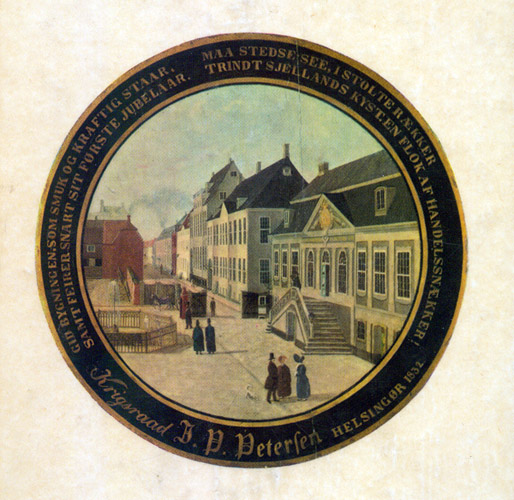
| | 1700-tallet blev en blomstringstid for især Helsingør og Landskrona, hvor der i begge byer blev opført pragtbyggerier i rokokko.
I Helsingør var det Toldkammerbygningen på daværende Toldkammerplads (-nuværende Wiibroes Plads), der var livsnerven i byens økonomiske liv. |
Helsingør
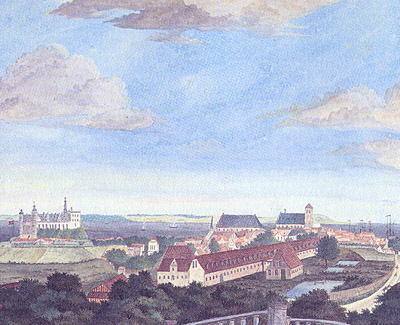
| | Det er rebslagervirksomhedens bygninger, som her dominerer billedet af Helsingør; et godt eksempel på den store erhvervsaktivitet, som prægede Helsingør i sidste halvdel af 1700-tallet.
Øget gennemsejling i Øresund og de stigende indtægter heraf er en væsentlig årsag til byens genopblomstring i den såkaldte florissante periode fra ca.1750-1850.
|
Den florissante by
Helsingør var alvorligt svækket efter krigen og pesten i begyndelsen af 1700-tallet og endnu i 1735 var der kun ca. 3400 indbyggere. Tiden herefter bliver for byen, som for landet som helhed en opgangsperiode, der kommer til at vare århundredet ud. Tidsrummet går under betegnelsen den florissante periode og henviser til en blomstring i forbindelse med stigende udenrigshandel og i mindre grad en udvikling af erhvervslivet.
For Helsingørs vedkommende er der først og fremmest tale om en øget indtjening og omsætning som følge af en stigning i gennemsejladsen i farvandet. Dette kan illustreres med en række nøgletal. I 1500 tallet passerede næppe mere end 300 skibe, i 1600-tallet 1500, mens man omkring 1750 kom op på ca. 5000 skibe årligt, i 1790erne ca. 10.000. Under napoleonskrigene falder antallet katastrofalt, mens man i 1840erne kommer op på over 20.000 skibe årligt. Selve indtægterne af sundtolden, der frem til 1771 gik direkte i kongens private kasse lå i 1730erne på omkring 200.000 rigsdaler årligt i 1780-1790erne på 500-600.000 rigsdaler.

Prospekt af Helsingør | 
Helsingørs profil, 1754 | 
Prospekt fra 1763 | 
Kort fra 1778 |
Erhvervsindberetning
I en forordning af 25.6.1735 blev det pålagt alle stiftsamtmænd at indsende oversigter over de økonomiske forhold i landsdelene og byerne. Interessen er koncentreret om "Hvorudi enhver By og Distrikts Handel, Negocie(Storhandel), Haandtering og Næring bestaar".
I en generel indberetning, forfattet af rådmændene Andreas Becker og G. Hvid, beskrives i korte vendinger byens tilstand, f.eks. at de omkringliggende landbrugsområder producerer korn i et omfang af ca 500 tønder udsæd, at der indføres kød fra Skåne og i det hele taget fødevarer fra andre landsdele. For så vidt er der ingen afgørende ændringer i byens forsyningssituation siden 1500-tallet. Byen kunne altså ikke brødfødes fra oplandet alene.
Af større virksomheder nævnes kun enkelte, et garveri og desuden et tobaksspinderi. De laugsorganiserede fag opregnes og som et tilsyneladende stort problem omtales "... de store indgreb som vederfartes dem af fuskere og efterliggende soldater foruden af garnisonen, som her forefindes, der lettere kan give deres arbejde til fals, end de her skatter og skylde, hvis befales og påbydes". Seks købmænd i byen klager ikke uventet over at bryggere, håndværkere og færgemænd udover deres metier driver ukontrolleret handel og de stiller forslag til en opstramning af reglerne for købmandskab i byen. Måske er det medvirkende til, at der i 1744 oprettes et kræmmerlaug med laugsskrå, i første omgang udelukkende med danske medlemmer.
Merkantilistisk tankegang
En anden indberetning er interessant fordi den kommer med forslag til forbedringer i pagt med tidens merkantilistiske tænkning, hvor man søger at opnå en positiv handelsbalance gennem satsning på egenproduktion og selvforsyning, som oftest i form af monopoler på udenrigshandel og produktionsvirksomhed. Dette synspunkt kommer f.eks. til udtryk i indlæggets paragraf 12:
"Overalt bør man søge ey allene at conservere Pengene i Landet men vel og at faa derhen, at man kan fortiene noget af de fremmede, hvilket er den Gevinst og Fordel, som man med Føye kan sige, at Landet profiterer mest ved."
Selvforsyningen er således det bærende tema, men man bemærker også i paragraf 6 den for tiden karakteristiske sammenkobling af erhvers- og socialpolitik:
"Fattige, som man desto værre finder i stort Tal på Gader og Stræder, kunne forsørges paa den Maade, naar de til Arbejde blev employeret, som allerbest lader sig gjøre, hvor Manufakturer oprettes og fortsættes, der kan baade Gamle og Vanføre fortjene til deres Underholdning og fortjene deres Brød, saavel med at spinde, med at karte Uld og andet Arbejde, som derved i Mængde forefalder; og om det vel i Begyndelsen vilde komme noget besværligt ellet uvandt fore, saa finder det sig med Tiden allerhelst, naar de Fattige beflider den Forskiel udi deres Forflegning ved Arbejdet og naar de til førend ved Bettelstaven haver maattet samle deres Føde."
En sådan politik har man siden Christian 4.s tid praktiseret i de statsmanufakturer, der bl.a. producerer luksustekstiler. Et enkelt lokalt forsøg gøres, da et antal forældreløse børn henvises til geværfabrikken i Hellebæk. Desuden kommer borgermester Tevis Wilde i 1770 med et forslag om at oprette et bomuldsspinderi med de fattige som arbejdskraft, hvilket dog ikke bliver til noget.
Engelske købmænd i Helsingør
En henvisning til fremmede indbyggere i paragraf 8 er meget aktuel, da der i byen hersker mistillid til det voksende antal fremmede, primært engelske købmænd, der profiterer af den voksende gennemsejlads og handel i tiden. De overtog størstedelen af handelen med engelske skibe, vægrede sig under dække af konsulær status ved at betale skat til byen og havde problemer med det i 1744 oprettede kræmmerlaug.
Et interessant eksempel er skibskaptajn John Daniel Belfour, der i 1786 ønsker at nedsætte sig som handlende i byen og søger om optagelse i kræmmerlauget. Det nægtes han, men ansøger så kancelliet om ret til at drive handel udenfor lauget. Det afvises, men centralmagten befaler hans optagelse i lauget, efter han har taget borgerskab, hvilket så sker i 1787.
Belfour er en interessant skikkelse fordi han ikke blot holder sig til handelen, men også investerer produktivt i bl.a. et geneverbrænderi og et garveri. Brænderivirksomhed var et fribytterområde, fordi mange, der også var organiseret i andre laug udøvede denne virksomhed. Belfour går grundigt til værks, indkalder hollandske specialister og opnår et betydeligt lån fra staten. Virksomheden går godt, man når i en enkelt måned, i november 1795 op på at sælge 21.536 potter og succesen fortsætter trods det at brændevinsbrænderne i Helsingør og Hillerød klager over ham i 1799.
Belfour var en virksom herre, der ikke lod sig stoppe af laugenes modstand på dette og andre områder.
Købmand Claessen
Købmand Jean Jacob Claessen var ud af en rig slægt, han far nævnes således i 1756 som den eneste i byen, der ejede egne skibe til udenlandsfart, og ligesom denne giftede han sig ind i en anden fremtrædende familie i byen, van Deurs-familien. I 1784 ansøger han om at anlægge et skibsværft med tilhørende ankersmedie og reberbane. Skibsværftet bliver ikke til noget, men interessant er det, at Claessen opnår særstilling i forhold til både smede- og rebslagerlauget, som på det tidspunkt end ikke forefandtes i Helsingør. Claessen havde endvidere planer om et større havneanlæg, der kunne fremme fjernhandelen, men staten ønsker ikke at støtte denne virksomhed.
I 1764-67 anlægges den første egentlig havn, idet man forlænger den eksisterende skibsbro, tilføjer en arm og tillige bygger en nordre arm. En udvidelse bliver først en realitet omkring 1824.

Havnen og Toldkammeret |
Nye initiativer
Af andre tidlige industrivirksomheder i århundredet kan nævnes lakfabrikker, en hårdugs- og vatfabrik, en stivelse- og pudderfabrik(1785), et sæbesyderi (1790), et eddikebryggeri og et tobaksspinderi(1793). Ingen af disse får dog varig betydning i modsætning til et par sukkerraffinaderier, der opføres fra ca. 1760-70, og hvoraf Adam Späths smukke rokokobygning ved Svingelport endnu forefindes, som et eksempel på tidligt erhvervsbyggeri.

Sukkerraffinaderi |
Havnefrontens palæer
Den stigende aktivitet og omsætning hen imod midten af 1700-tallet satte på forskellig vis sit præg på byen. Især på havnefronten. I årene 1740-42 blev der således opført et nyt Øresund Toldkammer på den daværende Toldkammerplads (nuværende Wiibroes Plads).
Det blev et pragtbyggeri i en blanding af barok og rokoko udformet af en ukendt arkitekt, N. Basse. Bygningen var placeret på hjørnet af forlængelsen af Strandgade og Sophie Brahesgade. På grund af Sundtoldens ophævelse i 1857 og en havneudvidelse omkring 1860 blev pragtbyggeriet, desværre, nedrevet.
Halvdelen af bygningen og dens forplads ville i dag rage ud over Havnegade og lidt ud i havnebassinet. Tilbage står et mindre sandstensløveornament fra 1829 og en rest af et af facadens vinduesornamenter på museumsinspektør Lars Bjørn Madsens kontor i Klarergården tæt ved Wiibroes Plads i Strandgade.
Den øgede velstand kan endnu iagttages i det omfattende byggeri af nye, store privathuse og handelspalæer rundt omkring i byen. F.eks. på den nuværende Havneplads ved Helsingør Station.

Rasmussens Gård 1780 | 
Det Claessenske Palæ 1791 | 
Stephan Hansens Palæ 1760 | 
Toldkammerpladsen | 
Øresunds Toldkammeret 1742 |

Toldkammermaleri |
Færgemænd og værtshuse
Den florissante periode gav også økonomisk fremgang for Helsingørs mange færgemænd og værtshusejere. I Helsingørs "nye" gade, Strandgades sydligste del, kan man stadigvæk se en hel del af disse solidt opførte bindningsværkshuse. I 1970,erne opstod der stor interesse for at bevare og restaurere disse historiske huse. F.ex. værsthusene "Ankeret" i Strandgade 27 og og værtshuset "Norske Løve" i Strandgade 19-21.

Bindningsværkshus Helsingør | 
Strandgade 19 Restaurering 1 | 
Strandgade 19 Restaurering 2 | 
Strandgade 19 Restaurering 3 |
Landskrona
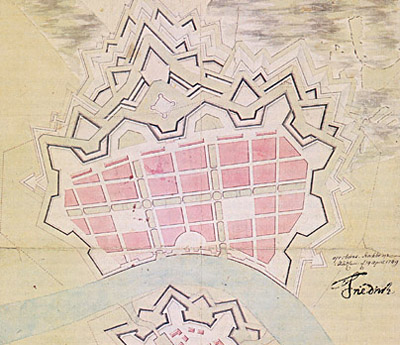
| | De skånske byer var små i forhold til de sjællandske. Men i 1749 blev der i Landskrona satset på en omfattende byplan. Den tog bl.a.udgangspunkt i et nyt militært befæstningsanlæg og betød nedrivning af en gotisk katedral med næsten samme størrelse som Lunds Domkirkes imponerende dimensioner.
Landskrona fik en stil efter 1700-talets ideal, men den totale visionen blev ikke virkeliggjort. |
Byerne - Landskrona
Ikke bare det skånske land var kommet bagud i udviklingen. Det samme gjaldt også de skånske byer. Man får et fingerpeg om byernes indbyrdes betydning som købstæder, fordi Linné nævner antallet af borgere (købmænd) i hver by. Malmö havde 350 stk., Lund 196, Landskrona 150, Helsingborg 130 og Ängelholm 70-80. Malmö var i 1750´erne den eneste by som Linné så som betydende.
Landskronas udvikling
I Landskrona beundrede Linné den store og smukke kirke. ”som nu skulle formindskes til fordel for det nye fæstningsværk”. Man havde ved denne tid opfrisket idéen om at videreudvikle Landskrona. Linné beskrev dette foretagende i sin Rejse i Skåne:
”… nu bygges stengader ud i selve havet på den sydvestlige og vestlige side. Mellem disse skal kvarterene fyldes op og bebygges og byen funderes, så at skibene kan fortøje ved kaj langs med husene i en sikker havn. Dette er et værk som ligner Herculis og som ikke af andre end konger og potentater kan efterlignes.”

Landskronas byplan 1749 | 
Landskronas befæstning | 
Borgmesterhuset i Landskrona |
Ny byplan
Den svenske rigsdag havde i 1747 besluttet at byen igen skulle befæstes med et nyt stærkt citadel på den lille ø Gråen ud for Landskrona. Fra denne ø skulle et befæstningsværk beskytte havnen og den nye by, som skulle bygges syd for den gamle. I 1749 havde Fredrik I godkendt den nye byplan, som denne gang havde en rektangulær form.
Eftersom man byggede store dele af byen udenfor strandlinien skulle et system af kanaler dræne området. Kanalerne byggedes efter hollandsk forbillede, da man anlagde en gade mellem husene og kanalen, ligesom i Nyhavn i København. Slotsarkitekten Carl Hårleman fra Stockholm prægede udformningen af bygningerne.
Kirken skiftes
Hårleman var også manden bag den nye kirke, som påbegyndtes i 1754 men indviedes dog først i 1788. Kirken fik navnet Sofia Albertina efter Gustav 3.s søster.
Den gamle gotiske kirke, som var næsten lige så stor som Lunds domkirke, blev nedrevet. Man mente, at kirken lå for tæt på den gamle fæstning, og man var bange for at en fjende kunne okkupere kirken og derfra beskyde fæstningen. Desuden var kirken forfalden og indeholdt masser af bygningsmateriale, som kunne bruges til nye projekter. Både strategiske og økonomiske årsager lå bag nedrivningen af en af Nordens pragtfuldeste gotiske kirker.

Den gamle kirke i Landskrona | 
Den nye kirke i Landskrona | 
Den nye kirke i Landskrona |
Projektet stoppes
Arbejdet med det nye Landskrona trak ud og blev samtidigt alt for dyrt. Da Sveriges finanser blev anstrengte under krigen mod Rusland i 1788, nedlagdes projektet, og den nye by blev kun halvt fuldendt. Til trods for at planerne ikke fuldførtes fik Landskrona et tydeligt 1700-talspræg, og i dag finder man adskillige bygninger fra den tid, da man prøvede at skabe en ny moderne by i tidens ånd.Skovreformer
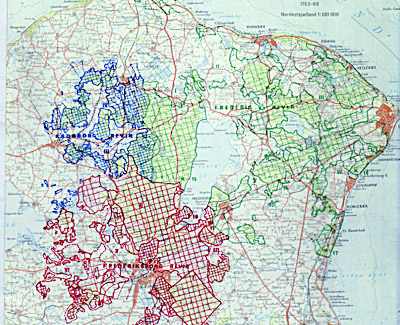
| | Det danske kongeriges træforbrug var stort og voksende i 1600- og 1700-tallet. Byggeri, opvarmning og oprustning krævede sit og efter svenskekrigene i midten af 1600-tallet var situationen meget alvorlig. Store dele af landet var hærget, den herskende driftsform efterhånden uholdbar og reformer nødvendige.
Det afgørende gennembrud kommer i 1760erne med Von Langens ideer om ordnet skovdrift. |
Med kongemagtens overtagelse af klosterjorden efter reformationen gribes der på forskellig vis ind i landskabets udvikling. Kongen var frem for alt interesseret i jagten, dernæst hesteopdræt og andre hensyn var underordnet dette. I og med kongens interessere i jagten fik store dele af landskabet lov til at henligge uopdyrket, men hesteopdrættet og udviklingen af nye jagtformer fører i nogen grad til ændringer i kulturlandskabet. Som helhed har et forholdsvis åbent landskab, præget af blandet løvskov med høslet og græsning i underskoven, været det karakteristiske i Nordøstsjælland.

Træbevoksningen | 
Græsningsskoven |
Produktionsskoven
Skoven har i høj grad karakter af produktionslandskab som på forskellig vis er udsat for menneskets tryk og påvirkning. Bønderne, som der ganske vist ikke var så mange af, var vigtige for driften af kongens ladegårde og som arbejdskraft ved stutteriet og i skoven.
Fra gammel tid havde bønderne ret at udtage træ til de gærder der omgav de dyrkede marker, til brænde og oldendrift med svin. Disse aktiviteter har selvfølgelig også sat sig spor i landskabet. F.eks. har oldendriften, ligesom græsning, stor betydning for skovens opvækstmuligheder.
Skovene ødelægges
Var den løbende udnyttelse af skoven et problem for reproduktionen, så satte de svenske belejringer omkring 1660 satte det nordsjællandske landskab under hårdt pres og voksende udnyttelse. I forvejen betød den militære oprustning forøget hugst for at skaffe skibstømmer, men besættelseshæren fældede udover til eget forbrug også systematisk med salg for øje og for at forhindre fremtidig udnyttelse af egetræ til brug for flåden.
Tabet af Skånelandene betød yderligere pres på skovene i Nordsjælland til bl.a. brændeforsyning og træ til bygninger og skibe måtte nu hentes fra Norge eller Nordtyskland. Omkring år 1700 var skovene fortsat i elendig forfatning, og et betragteligt forøget kvæghold i skovene bidrog nu til yderligere forværring. Som en af de første debatterer forfatteren og oplysningsfilosoffen Ludvig Holberg at debattere dette anliggende og i første del af 1700-tallet modnes på forskellig vis tanken om reformer til gavn for skovens fremvækst.

Træ til opvarmning |
Initiativrige amtmænd
Den overordnede administration af kongens besiddelser i Nordsjælland lå efter enevældens indførelse i hænderne på kongens amtmand i Kronborg og Frederiksborg amter. Denne havde bolig og skriverstue på Frederiksborg Slot og tog sig af domsmyndighed og alle typer af forvaltning: Sager som vedrørte skovens drift, men også jagten og de områder der hørte til agerdyrkningen og driften af stutteriet. Amtmændene var således også inspektører ved stutteriet.
Amtsmandsembedet krævede med andre ord store evner og overblik og var et betroet hverv for udvalgte personer i enevældens tjeneste. Både amtmand Otto von Raben, som besatte embedet i perioden 1697-1717, og Friedrich von Gram, der overtog det fra 1718-1841, var samvittighedsfulde og initiativrige i forvaltningen. Von Raben havde gjort karriere ved hoffet, bl.a. som kongens kammerjunker og hofmarskal fra 1683. Von Gram havde tidligere beklædt embede som jagtpage, kammerjunker og hofjægermester i Sjællands stift.
Kulsvierne
Bønderne i Nordsjælland var i starten af 1700-tallet forarmede, jorden gav, bl.a. på grund af mangelfuld indhegning og tiltagende sandflugt, kun ringe udbytte. De fleste bønder måtte derfor supplere deres indtægter på anden vis, typisk igennem kulsvieri, fremstilling af trækul, som man solgte til byerne eller hoffet. F.eks. skulle der i 1718 leveres 1800 tønder kul til forbruget på Amalienborg og Rosenborg i København.
Kulsvierne fik betaling for leverancerne, men skulle til gengæld også betale for råmaterialerne som skulle udvises af skovbetjente, Der anvendtes kun resttræ, ikke fældet træ og vindfælder og det var forbeholdt de fattigste bønder.
Tidlige reformer
Allerede i 1703 forsøgte amtmand von Raben sig med en nyskabelse for at mindske forbruget af træ til indhegning af markerne ved at opsætte stengærder. Man satte dette år 14 favne ved selve Frederiksborg, allerede det følgende år var man nået op på 200 favne og i 1712 bestemmes det at bønderne skulle sætte stengærder i stedet for trægærder.
Et andet problem var oldensvinenes skade på skoven. I Kronborg amt drejede det sig omkring 1000 svin, som åd agern og bog, men også rodede jorden op til skade for opvæksten. I 1703 bestemtes det derfor af svinene skulle ringes, altså sættes ring i trynen, og i 1718 kom der forbud imod at indlade svin i kongens stutterivange. I 1721 ansættes en fransk forstmand på foranledning af overjægermester Frederik von Gram, men han afskediges efter to år og herefter går der omkring 40 år førend der for alvor sker noget.
Kvægpesten
Fra 1745 og frem hærges landet gentagne gange af kvægpest. En umiddelbar virkning heraf er mindre drift på skoven. Græsning og høslet fik mindre vægt og der blev større interesse for skovens evne til at producere vildtkød.
Det har formodentlig betydet at skoven i højere grad har formået at vokse til, at overskoven er blevet tættere og tømmerproduktionen dermed har kunnet forøges. Fra 1780 bestemmes det at der skal skydes af på vildtet i de fri vildtbaner i Nordsjælland med henblik på salg, - en bestemmelse der ligeledes reducerer udnyttelsen af skoven.
Den ordnede skovdrift
I 1741 overtager hofjægermester C.C. Gram ledelsen af Danmarks jagtvæsen og skovvæsen efter sin far. I 1747 udnævnes han også til overjægermester og i 1762 kommer han med en indstilling til kong Frederik 5.om reformer i skovvæsenet. Kongen godkender straks forslaget og fra Tyskland indkaldes Johann Georg von Langen, der allerede tidligere havde reformeret det norske skovvæsen, og nu bliver den praktiske leder af reformerne.
Von Langes ideer om såkaldt ordnet skovdrift går i korte træk ud på at skoven hvert år skulle give et lige stort udbytte, hvilket sikres ved en nøjagtig beskrivelse af rettigheder til anvendelse af skoven, og en opdeling i præcise enheder med en omdriftstid på ca. 100 år.
Et nyt træk som får afgørende betydning for skovlandskabets udseende er von Langes ide om større variation i antallet af træsorter. Traditionelt bestod skoven af løvtræer, fortrinsvis eg, bøg og ask, som man også bibeholder, men supplerer med nåletræer, som dermed holder deres indtog i det danske skovbillede.

C. C. Gram | 
Johan von Langen |
Skoven ændrer karakter
Von Langen går allerede 1763 i gang med ændringer på Søllerød Beridt, som omfattede Geel Skov og Rude Skov, og fortsætter i perioden 1764-66 på 7 revirer i de tre nordsjællandske amter. Den store Grib Skov er inddelt i flere revirer og revirerne tegnes ind på nøjagtige skovkort.
I 1768 kommer det første officielle, samlede kort over Nordsjælland. På dette kort kan man tydeligt identificere kongens jagtbaner med de rektangulære og diagonal-mønstrede vejanlæg. Kortet som helhed giver det indtryk, at størstedelen af landskabet er skovområder, men i realiteten var der udover indhegnede områder til par forcejagten ikke tale om en skarp adskillelse imellem skov og landbrugsarealer. Det finder først sted via en række de reformer der iværksættes omkring dette tidspunkt og hvis virkninger kan iagttages på et efterfølgende kort fra 1777.

Udtynding ved hugst | 
Skovrevirerne | 
Frederiks revir | 
Nye træsorter | 
Fyrretræ fra von Langens tid |
Adskillelse af jagt, skovbrug og landbrug
I 1778 foreslår overjægermester Gram endvidere en adskillelse af jagt og skovbrug, et ønske der imødekommes. I 1781 kommer endnu en reform, hvor hovedprincippet nu bliver at adskille skovbruget ikke kun fra jagt, men også fra landbruget. Det typiske skovbillede fremstår nu som skarpt afgrænsede, indhegnede og sammenhængende områder, der allerede i vid udstrækning er fremkommet i forbindelse med de igangværende udskiftningsreformer indenfor landbruget.
Med fredskovsordningen af 1805 vedtages at hvad der engang var skov skal forblive skov. Dette princip er i hovedsagen fortsat gældende. Fra dette tidspunkt begynder man også at indhegne skoven med de karakteristiske stensætninger, som endnu ses overalt i Nordsjælland. Ligeledes spores indhegningerne i mange stednavne på skovparterne fortsat: Teglstrup Hegn, Nyrup Hegn, Klosterris Hegn o.s.v.Landboreformer
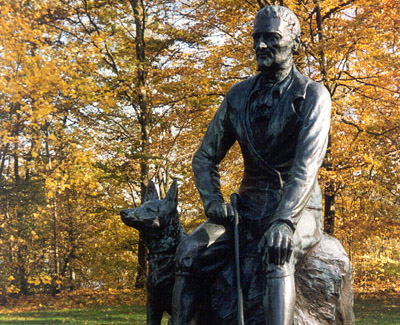
| | På begge sider af Sundet fandt der i sidste trediedel af 1700-tallet nødvendige og omfattende landbrugsreformer sted.
I Nordsjælland var det kronens gods, der i første omgang blev et eksperimentarium for en ny opdeling af jorden.
I Skåne var det Storgodsejeren Rutger McLean på Svanholms gods, som påbegyndte reformerne. |
Landboreformer - Sjælland
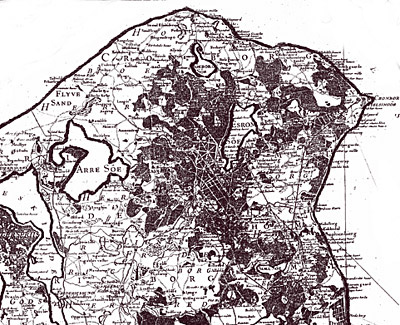
| | Nordsjælland var et centralt område i den første store reformbølge. Bl.a. fordi at man her kun skulle forholde sig til én godsejer, nemlig kronen.
Reformen betød bl.a. en ændring af kulturlandskabet, hvor de store skovarealer blev indskrænket.
På kortet over Nordsjælland fra 1768 ser man, omend lidt overdrevet, skovenes dominans før reformerne slog igennem.
|
Landbrugsreformer
Fra midten af 1700-tallet kommer der i Danmark en offentlig debat om land- og skovbrugsforholdene. Debatten er karakteristisk for oplysningstiden og den oplyste enevælde, hvor kongemagten på visse områder går i dialog med oplyste kredse i samfundet for at skabe nytænkning og udvikling. Et gennemgående synspunkt i debatten er at græsning og gærdeshugst er væsentlige årsager til skovenes slette forfatning og at man bør sigte på klarere brugsbestemmelser og adskillelse af skov og landbrug.
Jord og arbejdskraft
Den dyrkede jord der sorterede direkte under kronen i Nordsjælland var organiseret under fem ladegårde: Frederiksborg, Esrom Kloster, Kronborg, Kollerødgården og Ebbekjøbgården (senere Tulstrup og Knorrenborg Vang). Alle gårdene var bortforpagtet, bl.a. til amtslige embedsmænd, frem til 1717.
Kronens havde behov for leverancer af vildt, madvarer, brænde m.m., og havde derfor stor interesse i den arbejdskraft som bønder og husmænd leverede igennem hoveriarbejdet. For bøndernes vedkommende var der principielt ingen begrænsning i hoveriet, som udover omfattende arbejde med høslet for stutteriet og skovarbejde også omfattende kørsel for hoffet, hvor man undertiden skulle mønstre 100-200 vogne. Hertil kom f.eks. også transport af fødevarer og lån af sengeklæder. Husmændene var i reglen både håndværkere og landarbejdere, men havde dog den fordel at de kun skulle levere en dags hoveriarbejde om ugen.
Ryttergodset.
Årene 1713-14, midt under Den store nordiske Krig, var udprægede kriseår for jordbruget, bønderne forarmedes udover evne og amtmand von Raben tager initiativ til en gennemgribende reform, hvor man skulle opgive korndyrkningen og overgå helt til høslet på markerne, udleje høslættet i skovene og sigte på at ophæve hoveriet.
Så vidt kommer det dog ikke, men i 1717 vedtages en gennemgribende reform om udlægning af ryttergods, hvorved i Nordsjælland 40 tdr. hartkorn jord udlægges til underhold af 120 ryttere og heste. Landsbyer nedlægges, ladegården i Kollerød udlægges til ryttergårde for en officer og 30-40 ryttere og i Esrum opføres rytterbarakker. Bønderne skulle være med til at underholde rytterne, men den fortsatte forarmelse medfører at man i 1723 må eftergive bøndernes restancer i rytterpenge.
Stutteriets dominans
Rytterreformen er som udgangspunkt en militær reform, som også bringer en vis forandring i de dyrkningsstrukturelle problemer. Et problem havde man dog ikke imødeset, nemlig at der som følge af inddragelsen af den dyrkede jord opstår problemer med fødevareforsyningen i de større købstæder, heriblandt Helsingør..
Vigtigst var dog nok at man nu satsede ensidigt på produktion af hø til det kongelige stutteri, som sammen med ryttergodset kommer til at optage størstedelen af produktionsjorden i Nordsjælland. I 1720 er man således fra de oprindelig 10 nu kommer op på næsten 50 græsningsvange med et samlet areal på 62,5 kvadratkilometer. Antallet af heste var i første halvdel af 1700-tallet op imod 1600 og man havde behov for omkring 8000 læs hø og græs årligt.

Stutterivange 1720 | 
Stutterivangene 1765. |
Høsletsarealerne
Behovet for foderhø i stutteriets storhedstid var altså ganske enormt og stort set alt blev taget i brug. Bedst egnede til både høslet og eftergræsning var dog de opdyrkede områder og skovengene, specielt i den vestlige del af det nuværende Gribskov. Strø Vang omkring det nuværende Strøgårdsvang var deciderede høsletseng, mens andre arealer også anvendtes til græsning i større eller mindre omfang.
Det enorme behov for arbejdskraft blev på længere en hæmsko for ophævelse af hoveriet i Nordsjælland, men det forhindrer dog ikke at Nordsjælland på andre områder kommer tidligt med i reformprocessen.

Græssende heste | 
Træbevoksningen | 
Græsningsskoven | 
Høsletseng | 
Strøgårdsvang |
Udskiftning og udflytning
I 1757 nedsættes en kommission ”til landvæsnets fremtarv og nytte”, hvilket i 1758 resulterer i tre udskiftningsforordninger for Sjælland, Møn og Amager. Forordningerne sigter hovedsagelig på at ophæve fællesskabet på overdrevene imellem en landsbys medlemmer, eller flere landsbyer.
Private godsejere eksperimenterede i de efterfølgende år med mere vidtgående reformer og i 1766, efter Christian VII.s tronbestigelse, påbegyndtes reformer med ophævelse af fællesskabet imellem bønderne på krongodset i Københavns amt. Endnu en kommission, i 1768 omdannet til Generallandvæsenskollegiet, kommer i 1769 med en mere vidtgående udskiftningsforordning som tager sigt på at overdrev også inden fire år skal være ”delte og fralukkede” og fra 1776 sættes fokus på udflytningen og der stilles midler til rådighed herfor.

Nordsjælland 1768 | 
Nordsjælland 1777 | 
Stjerneudskiftning | 
Udskiftningsreformer |
Den lille Landbokomission
I 1784 nedsættes en landbokommission for Kronborg og Frederiksborg amter, den såkaldt Lille Landbokommission, og herefter går det stærkt med udskiftningerne i Nordsjælland: i 1789 er jorden udskiftet i 113 landsbyer og året efter er man færdige. Samme år er ikke mindre end 423 gårde og 257 huse udflyttede og dermed er landskabet for alvor ved at skifte karakter. Småskovene og de spredte træer på overdrevene er forsvundet, det dyrkede areal er forøget på bekostning af overdrevene og gårde og huse rejses i det åbne land, således som det fortsat er tilfældet.
Udskiftningen var det vigtigste resultat af Den lille Landbokommissions arbejde og tillige den reform der har størst betydning for ændringen af kulturlandskabet. Andre opgaver var afløsningen af hoveri og tiende med pengevederlag og desuden arbejdedes der for at udbrede kendskabet til bedre sædskifte med nye afgrøder som f.eks. kartofler. Endelig opførtes i de to daværende amter ikke mindre end 35 skoler i årene 1784-90.
Nordsjælland som eksperimentarium
Når Nordsjælland blev valgt som fokus for den lille landbokomission og dermed den første store reformbølge hang det naturligvis sammen med at man her kun skulle forholde sig til en godsejer, nemlig kronen, eller om man vil staten. Desuden var det af to årsager en forholdsvis overskuelig opgave. Krongodset omfattede kun omkring 160 landsbyer med omkring 1300 gårdejere og hertil kom at en stor del allerede var udskiftet ved de første reformbestræbelser tilbage i 1760erne og 70erne.
Det er nok også forklaringen på at ændringerne i landskabets karakter tydeligt kan øjnes allerede på kortet fra Videnskabernes Selskab fra 1777, sammenlignet med et tilsvarende kort fra 1768. Udskiftningskort for de enkelte landsbyer giver et detaljeindblik i processen og ændringerne på lokalt plan. På udskiftningskortet fra Horserød kan man f.eks. tydeligt iagttage det gamle og nye dyrkningsmønster, hvorledes overdrevsjord og tidlige skovareal inddrages i processen og en klar adskillelse imellem agerjord og skov opstår.

Nordsjælland 1777 |
Sandflugt og skovrejsning
Sandflugt og vandreklitter har sammenhæng med skovfældning og overgangen til landbrugsproduktion og allerede i 1200-tallet er der tegn på tiltagende sandflugt. Den middelalderlige krise i 1300-tallet i forbindelse med Den sorte Død, nedgang i befolkningstallet og ødegårde giver landskabet mulighed for at regenerere og på Sjælland springer tidligere landbrugsområder flere steder i skov. Den situation varer frem til engang i 1600-tallet, hvor befolkningsstigning, krig og ødelæggelse igen udsætter naturgrundlaget for øget pres.
I Nordsjælland er tidligere rige landbrugsområder nord for Arresø opgivet og indsejlingen til både Arresø og Søborg sø er blokeret. I starten af 1700-tallet er situationen under hastig forværring i Nordsjælland og f.eks. også på Bornholm og statsmagten tager nu initiativ til at bremse denne udvikling. Som i tilfældet med skov- og landbrugsreformerne tager man først fat i Nordsjælland.

Sandflugten |
Læhegn og beplantninger
I 1702 klagede Tisvilde og Tibirkes beboere deres nød til kongen med henvisning til at sidstnævnte landsby var næsten ødelagt af sandflugten. Bønderne får hjælp til at opsætte gærder og nedslag i skatten, men først i 1724 bliver der taget initiativ til en mere målrettet bekæmpelse med ansættelse af Ulrich Röhl til ”Inspektør ved flyvesandet på Kronborg Amt”. Der plantes ved indforskrevne hovbønder marehalm og hjelm og beklædes med græstørv i en 15-årig periode.
På Videnskabernes Selskabs kort fra 1777 bemærker man, at der i sammenhæng med den generelle reduktion af skovarealet faktisk også er tale om skovrejsning langs Nordkysten, bl.a. de områder der i dag rummer Asserbo og Hornbæk plantager. Disse områder er tilplantet med henblik på at stoppe den tiltagende sandflugt, som efterhånden havde udartet sig til en økologisk katastrofe i hele landet og ligeledes i Skåne.
Beplantningerne følges op med læhegn i form af skovbeplantninger. Den første påbegyndes i 1726 ved Tisvilde. Tisvilde Plantage udvides i 1793 med 27,5 ha skovfyr, samme år anlægges 14 ha ved Hornbæk og i 1799 følges op med en beplantning ved Sonnerup Skov i Odsherred.

Bekæmpelse af sandflugt |
Skåne
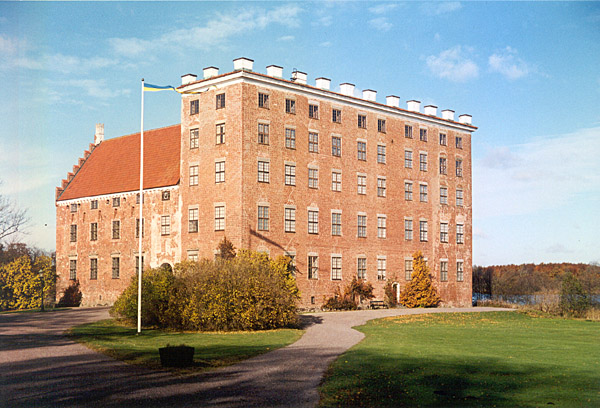
| | På Svanholms gods i Skåne blev der påbegyndte reformer indenfor landbruget, som igen banede vej for industrialiseringen.
Dog ikke uden voldsom modstand fra bønderne. |
Det forældede landbrug
En landsby i Skåne udgjordes fra gammel tid af en sammenholdt bebyggelse med opsplittede jordbesiddelser. Det opdyrkede område bestod af dele af vidt forskellig kvalitet. Retfærdighed var blevet tilstræbt ved at give flere mindre markstykker af forskellig kvalitet til hver enkelt bonde. Området blev derfor opsplittet i et stort antal små agre, og situationen blev med tiden uoverskuelig pga. arvedeling.
Omkring 1750 blev man klar over, at en rationalisering af landbruget krævede større og bedre sammenholdte enheder. De stigende priser på landbrugsprodukter, som hængte sammen med den stigende befolkning i Europa i midten af 1700-tallet, krævede forandringer. Samtidigt var landbruget i Skåne blevet forringet af jorderosion, sandflugt, krigens hærgen og vanrøgt. Linné havde, under sin rejse i Skåne, bemærket problemerne med det forældede skånske landbrug.
”Bonden i Skåne holder ligeså ihærdigt fast ved sine forfædres vaner, som vor tids ungdom er hurtig til at forandre dem.”

Forårspløjning |
Reformforsøg
Mens bonden vogtede på sine gamle metoder viste myndigheder og enkelte godsejere interesse for at rationalisere. En plan var, at gennemføre et ejerskifte, så at hver bonde fik større men færre besiddelser, dvs. en udvikling imod større enheder.
For at løse problemet med den svingende jordkvalitet gav man ”karakterer” til de forskellige agre. Gennem at bonitere (kvalitetsbestemme) jorden skulle man bytte god jord mod ringere med større areal. Denne plan blev fremført af inspektoren ved Landmålingen, Jacob Fagott, i hans bog ”Det svenske landbrugs hindring og hjælp” (1746). Ifølge Fagotts idéer ville han beholde byerne men agrene skulle slås sammen til mere sammenhængende enheder. I 1757 udfærdigedes en kundgørelse om udskiftningsreform i Skåne.
Mange bønder var modstandere af denne reform. Man var bange for en uretfærdig fordeling af jorden, ulemper med marker som lå alt for langt fra byen samt problemerne med et større areal med ringere jord, når der var mangel på billig arbejdskraft. Udskigtningen blev derfor ikke helt fuldført, og regeringen trak deres dekret tilbage i en ny kundgørelse i 1783, i hvilken det blev bestemt, at hver bonde måtte have op til otte agre.
Udskiftningsreformen blev med andre ord ikke nogen succes. Brugernes marker var stadigvæk opdelte om end ikke i samme omfang som tidligere.
Macleans planer - en oplyst despot
En mere radikal forbedring af landbruget krævede måske, at bondens gård placeredes der, hvor hans marker lå. Rutger Maclean på Svaneholms gods i det sydlige Skåne havde tanker i den retning. Han var formentlig påvirket af de Udskiftningsreformer, man havde gennemført i Danmark efter 1781, men lignende reformer var også tidligere blevet gennemført i England, som den rejsevante Maclean havde besøgt flere gange.
I 1780´erne gennemførte han en radikal landbrugsrevolution på sit eget gods. Som en mand af oplysningstiden, var han ikke bange for at bruge de metoder, som en oplyst despot så som nødvendige.
På Svaneholms marker fandtes den gang flere landsbysamfund med gårde i forpagtning. De forpagtende bønder udførte hoveri på godset og betalte sin forpagtning in natura. Maclean forandrede hele dette system. Han slog agrene sammen, udstykkede jorden i betydeligt færre sammenhængende lodder (som regel kvadratiske), afskaffede hoveriet, indførte pengebaseret forpagtning og byggede en ny bondegård midt i hvert lod. Dette viste sig meget effektivt og godsets produktivitet øgedes betydeligt.
Maclean var, som en sand oplysningsmand, også aktiv i andet udviklingsarbejde. Han eksperimenterede med nye metoder og skrev lærebøger i landbrug. Han ville forbedre undervisningen i skolerne, byggede skoler og viste interesse for Pestalozzis pædagogik, som endnu i dag delvis kan ses som moderne. (Pestalozzi betonede evnen at indhente kundskab mere end selve kunskabsmængden.)

Rutger Maclean | 
Svaneholm gods | 
Udskiftningskort fra Svaneholm | 
Udskiftninger i 1800-tallet | 
Før og efter udskiftningen |
Andre fremsynede godsejere
De fremgangsrige forandringer på Svaneholm fulgtes op af andre godsejere. I 1802 traf Maclean overdirektøren for Landmålingen, Eric av Wetterström, til et møde i Helsingborg og overbeviste denne om fordelene med den udskiftning, som var blevet gennemført på Svaneholm. Idéerne kom den svenske konge Gustav IV Adolf for ører, og han bifaldt planen. I Skåne indførtes udskiftningen i 1803, og derefter spredtes reformen videre nordpå i landet. Det var imidlertid i Skåne, man gik mest hårdhændet frem, og allerede i 1825 var halvdelen af alle Skånes landsbyer blevet skiftet.
Produktionsforøgelse og statarsystemet
Nye og bedre kundskaber indenfor landbrug, samt udskiftningen resulterede i en højere produktivitet. Det gamle vekselbrug, med udelukkende korndyrkning varieret med braklægning, udskiftedes med flerårige dyrkningsmønster med både korn- og foderproduktion og med kun en lille del af jorden braklagt.
Samtidigt voksede interessen for anvendelse af nye maskiner og værktøj. Hoveriet afskaffedes, og i stedet opstod et proletariat af landarbejdere, da det specielle svenske statarsystem blev indført. Systemet indebar, at godsejeren fik faste, fuldtidsansatte landarbejdere til en lav omkostning. Lønnen udgjordes for en stor del af ”stat”, dvs. naturalier.
Kapitalisering af landbruget
Landbrugsrevolutionen medførte en kapitalisering af landbruget, og de sidste rester af det feudale system forsvandt. Godsejere og myndigheder tilskyndede revolutionen, mens almindelige bønder ville blive ved det gamle. Det var altså ikke en revolution, som førtes af de lavere samfundsklasser. Mange bønder følte, at de betalte en høj pris. Det gamle trygge landsbyfællesskab forsvandt, og gårde blev revet ned. En helt ny livsstil blev indført, som var præget af konkurrence og individualisme. Private interesser blev vigtigere end fællesskabet. Landskabet blev også kedeligere, da den gamle landsbygade forsvandt og naboen var flere kilometre væk.
Man kan godt forstå, at den nye pietistiske fromhed havde gode vækstmuligheder i disse omgivelser, og at den delvis kunne udkonkurrere den gamle kollektive religiøsitet. Mange bønder ramtes hårdt af forandringerne, som de oplevede som tvangsmæssige og uønskede.
På landet opstod nu kraftige modsætninger mellem samfundsklasserne. I de endnu uskiftede landsbyer sluttede man sig sammen for at undgå de nye idéer. Ved et bondeoprør (brødoprøret) i Malmö i 1799 viste hundreder af bønder deres utilfredshed med klasseforskellene. Fattige bønder angreb det etablerede samfund og truede det. Det gamle landsbyfællesskab kunne tydeligvis udgøre en fare for myndighederne.
Bondesoldater
Under Napoleonkrigen styrkedes bøndernes sammenhold yderligere imod magt og myndighed. Danmark og Sverige stod på den modsatte side i krigen mellem Frankrig og Storbritannien. Sverige truedes af krig fra Frankrig gennem dets allierede, Danmark. I 1808 blev det påbudt at opstille tropper. I Skåne blev det til seks bondebataljoner, hvor soldaterne levede under elendige forhold, uden ordentligt udstyr. Samme år udbrød der krig mellem Sverige og Finland. Det var hårde tider og mange døde af sult og sygdomme.
Esaias Tegnér besang disse bondesoldater:
”Hør den krigeriske røst! Den kommer fra øst,
den drøner som stormen ved fædrenes strand;
den kommer fra vest, den ubudne gæst.
Til strid, til strid for fædreland!”
(Fra krigssang til den skånske bondehær)
I 1811 skulle hæren på ny forstærkes pga. en skærpet udenrigspolitisk situation. Det blev pålagt de store godser at levere ekstra soldater, hvoraf det store flertal fortsat skulle komme fra bondestanden. 15.000 bønder og karle skulle forstærke hæren.
Bondeoprøret 1811
Nu var tålmodigheden sluppet op hos de skånske bønder. Udskiftningen havde tvunget dem væk fra trygheden; de var tvunget ud i en elendig bondehær, og nu skulle de tvinges ud i en ny krig. Der fremkom en bølge af protester, og der opstod en modstandsbevægelse.
I Kullaområdet var engagementet stort, og i begyndelsen af sommeren 1811 samledes 800 bønder og karle på Ringstorp i Helsingborg for at protestere, og det kom til uroligheder. Kampladsen var den samme, som hundrede år tidligere var skuepladsen for slaget ved Helsingborg. Det kom til uroligheder over hele Skåne og især i Klågerup og Torup ved Malmö blev bondeoptøjerne meget vanskelige at håndtere for myndighederne.
Til og med Rutger Maclean, den reformvenlige godsejer, blev angrebet af værnepligtsnægtende karle og bønder. Da han en sommeraften i 1811 kom hjem til Svaneholm, var gården pakket med mennesker. Han blev gennet op på sit værelse og tvunget til at underskrive en forsikring om, at han selv skulle sørge for soldater til hæren.
Hårde straffe
Myndighederne slog hårdt ned på oprøret, og man adviserede strenge straffe. En ejendommelig straf blev indført: Lodtrækning. Hvis den dømte trak et gevinstlod, fik han den udmålte straf, men hvis han trak en nitte blev straffen halshugning. Man skrev benådningsansøgninger til kongen, og da de endelige domme faldt den 4. januar, 1812, havde kong XIII ophævet al lodtrækning og ændret de fleste dødsdomme. Mange af oprørerne blev imidlertid idømt hudfletning (prygl), eller/og tab af hånden og fængsel.
Bondeoptøjerne i Skåne i 1811 blev voldsomme og var måske en medvirkende årsag til, at opdelingen af landsbyerne måtte gennemføres på en så hurtig og brutal måde. Måske var det ikke bare landbrugets effektivisering, man havde i tankerne, da man så hurtigt sprængte byfællesskabet i stykker.Industrialisering
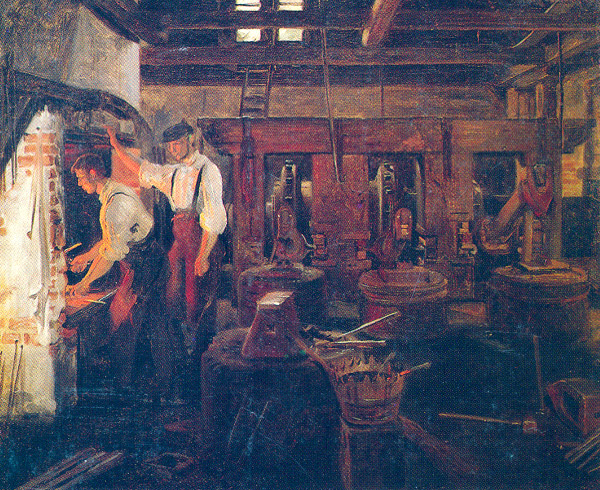
| | En tidlig industrialisering fandt sted på begge sider af Øresund.
I Höganes blev der ved slutningen af århundredet skabt forudsætninger for en omfattende produktion af flasker. Bl.a. til eksport til England.
I Hellebæk på sjællandssiden blev der igangsat en omfattende fabrikation af forladegeværer til den danske stat. Maleriet er dog fra midten af 1800-tallet. |
Industrialisering i Höganäs
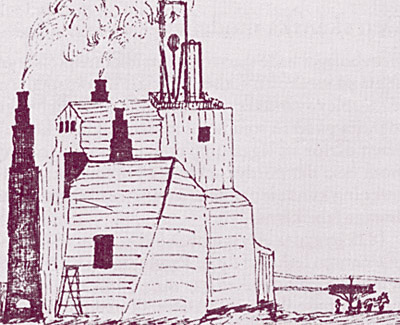
| | Der findes næppe noget som symboliserer industrialiseringen bedre en dampmaskinen. Her ses en tegning af dampmaskinen i Höganäs 1806. (fra Odenkrantz dagbog).
Industrialiseringen af Höganäs er et atypisk eksempel på, hvorledes industrialiseringen i Danmark og Sverige ellers foregik. |
En almindelig opfattelse er, at den svenske industrialisering så småt begyndte efter 1850, og at den først fik fart i slutningen af århundredet. I Sverige sættes den i forbindelse med savværksindustrien i Värmland. Men at den tidlige industrialisering først begyndte i midten af århundredet. Men ingen regel uden undtagelse. En sådan undtagelse er Höganäs, som i 1700-tallet var et lille fiskeleje ved det nordlige Øresund, men som allerede nogle få år inde i 1800-tallet blev forvandlet til en industriegn.
Stenkul
Stenkul associeres normalt med industrialisering, især i England. I Danmark blev stenkulsforekomsterne i Skåne af betydning som energikilde til fyrtårne og kalkbrænderier, og i 1600-tallet brød man stenkul i Helsingborg. Her lå forekomsterne let tilgængelige i jordbunden på skrænterne mod havet nord for byen. I Kullens fyrtårn fyrede man med dette stenkul. Men da Skåne blev svensk, mistede stenkullet sin betydning, da det hverken kunne eller måtte konkurrere med de svenske skove som energikilde.

Kullens fyr | 
Stenkul i Skåne |
Stenkul og ler
Den svenske innovatør, Jonas Ahlströmer, som en tid var konsul i London, talte i starten af 1700-tallet for, at stenkulsbrydningen skulle genoptages i Sverige. Eftersom Skåne var det eneste område i Sverige, hvor man havde fundet stenkul, startede han i 1737, Det Skånske Stenkulsværk. Kulforekomster opdagedes bl.a. i Vallåkra udenfor Helsingborg. Foretagendet var ikke særlig lønsomt, og markedet omfattede stadig stort set kun fyrvæsenet.
1786 overtog Erik Ruuth det Skånske Stenkulsværk. Han var greve, administrator, godsejer og blev desuden, i kraft af sin nye virksomhed, tidlig industrimand i Skåne. Han satsede stædigt, og til tider økonomisk dristigt, på det nordvestlige Skånes miner. Anders Polheimer, kendt bjergingeniør, blev ansat for at udføre prøveboringer, og han fandt fine forekomster; bl.a. i egnene omkring det lille fiskeleje, Höganäs, på Kullahalvøen. Dette skete egentlig som resultat af en tilfældighed. Polheimer havde fået øje på gult ler, som bønderne i området solgte som maling. Ved dybdeboringer fandt Polheimer ikke kun ildfast ler, men også stenkul af, efter skånske forhold, udmærket kvalitet.

Eric Ruuth | 
Stenkulsminerne |
Engelske ingeniører og de første svenske jernbaner
Formodentlig kom det ikke som nogen overraskelse for en bjergingeniør, at der var stenkul der, hvor der var rigelig med ler. Nu (1797) fremskaffede Ruuth ny kapital, og en rent industriel virksomhed begyndte. Han ansatte en engelsk mineingeniør, som kom fra egnen omkring Newcastle i det nordlige England. Han hed Thomas Stawford, og han så med forundring på sit nye underudviklede hjemland, hvor man ikke havde haft fornuft til at udnytte de fine naturresurser, og hvortil moderne teknik, endnu ikke var nået.
Stawford gennemførte beslutsomt en, på det nærmeste engelsk industrialisering. Den første dampmaskine installeredes allerede i 1798, og flere fulgte i de efterfølgende år. Disse brugtes til at tømme minerne for vand. De skakter, som man havde åbnet i Tjörröd, nord for Höganäs fiskeleje og i Ryd mod øst, havde den store fordel, at de lå forholdsvis tæt ved kysten, og transporterne til udskibningshavne blev derfor korte. 1801-1802 byggedes en kanal fra skakten ned til havet. Denne kanal kunne bruges til flere formål. Dels kunne vandet, som man pumpede op af minerne ved hjælp af Stanfords dampmaskiner, ledes bort, dels kunne kullet fragtes på pramme ned til anløbsstedet for udskibningen. En træskinnebane på næsten 2 km var allerede omkring 1800 blevet etableret mellem forskellige arbejdspladser. 1805 udskiftedes træskinnerne med jernskinner, og således havde Sverige fået sin første jernbane.
Glasværksindustrien og den nye arbejdsdeling
I 1801 gik man i gang med at bygge et glasværk til fremstilling af flasker. Stenkullet var en udmærket energikilde til glashytten (smelteovnen). 1805 produceredes her over 100.000 flasker, som først og fremmest eksporteredes til England og Frankrig.
Arbejdsstyrken i virksomheden var indledningsvis på 15 mand, men voksede hurtigt og i 1806 var 294 arbejdere registrerede i virksomheden. Disse var på daværende tidspunkt fordelt på følgende måde:
Tjenestemænd: 10 stk.
Minearbejdere: 131 stk.
Arbejdere ved maskinerne: 27 stk.
Arbejdere ved glasværket: 11 stk.
Håndværkere: 39 stk.
Transportarbejdere: 12 stk.
Altmuligmænd: 64 stk.
Arbejdet var til dels specialiseret, og f.eks. var minearbejderne inddelte i skaktfogder, sænkere, kulhuggere og kuldrenge. Lignende opdelinger forekom også i forbindelse med maskinarbejde og transportarbejde.
Arbejdskraften hentes andre steder fra
Rekrutteringen af arbejdskraft var under denne periode et problem, og landbrugets rationalisering havde endnu ikke frigjort arbejdskraft i Skåne. Arbejdskraftbehovet var så stort, at den lokale befolkning ikke var tilstrækkelig, og arbejdere blev ansat fra alle mulige kanter. Der kom glasblæsere fra Småland, soldater brugtes til kanalbyggeriet, hallændere, blekingeboere, englændere, tyskere og nordmænd ankom til Höganäs, ja, selv russiske krigsfanger benyttedes 1808-09. Det var ikke helt problemfrit med denne brogede skare. Stawford noterede således ofte i sin dagbog sine bekymringer over arbejdernes fuldskab og slåskampe.
Hårde vilkår
Stawford viste sig hårdhændet overfor arbejderne, men var respekteret af etablissementet for sin driftighed. Arbejdsdagen for en arbejder var normalt 12 timer lang. Klager blev ofte mødt med trussel om arrestation og andre afstraffelser. Kom man ikke i tide, kunne man blive pålagt arbejde i minen uden lys. Arbejdet var hårdt og svært i fugtige, trange mineskakt, og uheld og sygdomme hørte til dagligdagen.
Mange flygtede og børnearbejde forekom i stort omfang. Ifølge en fortegnelse over ”Stenkols Werkets Personal” i december 1827 fandtes der 260 arbejdende mænd og 85 arbejdende drenge, dvs. omtrent 25 % af de ansatte var børn. Men det var såmænd en nedgang sammenlignet med 1802, da cirka 35 % af arbejdsstyrken var børn, men meget tyder på, at det i lang tid var normalt med børnearbejde i Höganäs.
Samtidigt etableredes skoler og hospitaler, og man byggede boliger. Allerede i 1797 påbegyndtes byggeriet af arbejderboliger, som normalt bestod af et værelse med køkken på tilsammen 18 kvadratmeter. I disse lejligheder boede familier på 5-8 personer.

Arbejderbolig 1806 | 
Arbejderbolig 1814 |
Bygningskunst og ornamenter
I 1825 omdannedes virksomheden i stenkulsværket. Det var blevet mere lønsomt at bearbejde leret end at udskibe stenkul. Stenkullet brugtes derefter til opvarmning af ovne ved fremstillingen af lervarer, f.eks. tegl og lerkrukker. I 1856 ansattes den danske billedhugger Ferdinand Ring som ornamentbilledhugger ved Höganäsværket og dermed startede den kunstkeramiske produktion.
Den nyklassicistiske stil var nu meget udbredt indenfor bygningskunst, og denne arkitekturstil kendetegnedes især af ornamenter i rigt mål. Ring havde tidligere arbejdet for den verdensberømte danske billedhugger Bertel Thorvaldsen. Han blev i Höganäs til 1869. I byens midt kan man se eksempler på hans kunst, terrakottastatuer af Ruuth og Stenbock men også ornamenter på flere huse. Efter tiden i Höganäs flyttede Ring tilbage til Danmark. Her udførte han nogle berømte udsmykninger, bl.a. frontongruppen på Det Kongelige Teater i København og hans arbejder kan også beses i Marmorkirken.

Dekorerede facader | 
Ornamenter |
Höganæs og industrialiseringen som begreb
Man kan diskutere den egentlige betydning af ordet industrialisering, og der findes da også mange opfattelser og teorier, om hvornår den begyndte. Men hvis definitionen er, at industrialisering indebærer overgang til en kapitalistisk ejeform, investeringer i kapitalkrævende maskiner, ansættelse af lønnede arbejdere med vis specialkundskab, stor produktion, nye transportsystemer og en ”stempelurstilværelse”, så var Höganäs industrialiseret tidligt i 1800-tallet, halvtres år før industrialiseringen af savværksindustrien i Midtsverige.
Industrien i Höganäs opstod altså ikke indenfor det lokale landbrugssamfunds rammer og var heller ikke afhængigt af dette samfund, når det gjaldt rekruttering af arbejdskraft eller afsætning af varer. Arbejderne rekrutteredes, som vi har set, fra andre steder, og produkterne, både stenkul og glas, eksporteredes. Höganäs var blevet et lille industri-England med arbejdere, dampmaskiner, stenkul, kanal og jernbane. Og alt dette var i fuld gang allerede i 1805!
Eric Ruuths risikokapital, Anders Polheimers undersøgelser, Thomas Stawfords innovationer og driftighed men først og fremmest hundreder af arbejderes hårde arbejde, havde forandret det lille fiskeleje Höganäs til et industrisamfund. Det første af sin art i Skåne, måske i Sverige.Industrialisering i Hellebæk
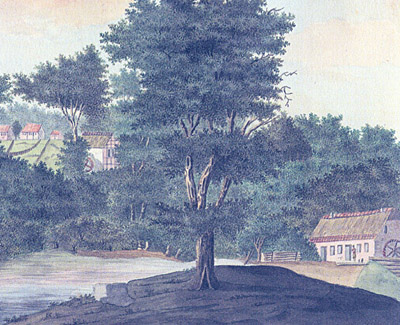
| | I 1700-tallet tager den begyndende industrialisering fart flere steder på Sjælland bl.a. i Hellebæk på Nordkysten seks kilometer fra Helsingør. Udgangspunktet var udnyttelsen af den vandkraft der var til stede her. I Hellebæk drejede det sig om fabrikation af våben, primært geværer til den danske hær. Hammermøllen, som ses midt i billedet, var den centrale del af forarbejdningsanlægget. |
Vandkraftens betydning
Ved påbegyndelsen af byggeriet på Kronborg i Frederik 2.s tid blev man opmærksom på mulighederne for at udnytte den vandkraft, der var til stede i omegnen, først og fremmest i Hellebæk. Med henblik på at forsyne de mange arbejdere med brød byggede man i første omgang en kornmølle helt nede ved stranden, men under Christian 4. begyndte man også at interessere sig for andre projekter. Da man omkring århundredeskiftet fandt myremalm i området iværksatte han et projekt, der tog sigte på at udsmelte og bearbejde jernmalm herfra. I 1601 beskikkes således en Poul Smelter til:
”...i den nye Smeltemølle, som vi ved vort Slot Kronborg haver ladet bygge, med Flid og uden Forsømmelse at skulle smelte og bearbejde den Jernerts, som sammesteds udi Lenet findes".
Forsøg med jernfremstilling
Projektet med jernfremstilling bliver aldrig nogen succes, det forlægges i stedet til Norge, men man fortsætter med at smede forskellige jernemner i et anseligt omfang, over 10.000 stykker smedegods til Frederiksborg Slot, bl.a. under ledelse af Caspar Fincke, der var mestersvend ved møllen i perioden 1622-1630. Der var tale om allehånde forskellige produkter, såsom låse, hængsler, dørklinker og viduesgitre. Der blev også opført en kobbermølle i området, antagelig med vand fra Kobberdammen som drivkraft, men omstændighederne er her mere uklare. Kobberplader skulle bl.a. anvendes til tag på kongens mange bygninger. Det samlede anlæg fungerede frem til omkring 1650, men ødelægges af svenskerne under krigen i 1658. Herefter går der omkring 100 år før der for alvor kommer gang i tingene igen.
Udnyttelse af vandkraften
Forudsætningen for hele foretagendet var udnyttelsen af vandressourcerne i området og det omfattende reguleringssystem, der skulle sikre stabil vandtilførsel hele året rundt.
Det centrale område for udnyttelsen af vandkraften er Hellebækken, der løber fra Bondedammen til stranden nedenfor med et fald på over 20 meter. Arbejdet med at opdæmme og udnytte vandkraftsystemet påbegyndes i 1575 med arbejdskraft fra Helsingør. I første omgang tager man fat på den nedre del af systemet, men allerede i 1577 graves der en kanal imellem Sortesø og Klaresø. Der har ligget et stort arbejde i den løbende vedligeholdelse af både vandsystemet og møllerne.

Hammermøllen | 
Vandsystemet ved Hellebæk |
Geværfabrikken i Hellebæk
I starten af 1700-tallet er der planer om at anlægge en geværfabrik i Hellebæk, men først da værket sættes på auktion i 1743 og regimentskvartermester Stephan Hansen fra Helsingør overtager det for 15.250 rigsdaler bliver det for alvor til noget.
Stephan Hansen er et godt eksempel fra denne tid på en borgerlig, egentlig bondesøn, der med flid og arbejdsomhed tjener sig op i samfundet. I forbindelse med anlæggelse af geværfabrikken oplever vi ham som privat iværksætter, idet han ganske vist får monopol på at fremstille geværer i 20 år. I 1743 var han ved at gøre karriere indenfor militæret og fungerede også som købmand i Helsingør. I perioden fra 1750-1770 havde han desuden handelsret på Færøerne. Omkring 1750 lader han Hellebækgård opføre i sammenhæng med sine udvidelser af foretagendet.
Stephan Hansen formår at reorganisere og forny hele værket. Gamle bygninger istandsættes, han indkalder fagfolk fra udlandet og opfører en række nye bygninger, heriblandt de karakteristiske gule mesterboliger i Bøssemagergade, hvor en række håndværksmestre og deres svende boede og arbejdede.
Samtidigt kort over anlægget
I 1752 tegnede en ansat ved værket et kort over anlægget. Kortet viser strækningen fra Bondedammen og ned til kysten. Ifølge kortet er der på dette tidspunkt 2 hammermøller. Det menes, at den ene har haft et såkaldt overfaldshjul, den anden som det nu kan ses på den restaurerede mølle et underfaldshjul. Den oprindelige mølle ombygges i Stephan Hansens tid og står færdig 1765, samme år som staten køber værket tilbage.
I forbindelse med restaureringen af møllen omkring 1980 har man rekonstrueret den udvidede mølle fra 1765. Møllehjulene var placeret ved gavlenden. Det højeste hjul, 6 meter i diameter og 3/4 meter bredt, driver blæsebælgen til essen indenfor, mens det lavere hjul, 5 meter i diameter og 1,5 meter bredt, driver to hamre, en såkaldt strækhammer, hvis hoved vejer 100 kilo, og en løbhammer, der vejer 20 kilo. der er endvidere forbindelse til blæsebælgene på loftet.

Kort over anlægget 1752 | 
Hammermøllen | 
Tværsnit over mølleværket | 
Den ny hammermølle |
Overgangen fra håndværk til industri
Interessant ved værket i Hellebæk er dets karakter af overgangsform fra rent håndværksmæssig produktion til den senere tids egentlige industri.
Karakteristisk for håndværket er, ideelt set, at få faglærte arbejdere individuelt udformer produkterne med enkle redskaber og i reglen til et kendt marked, som f.eks. Helsingør med opland.
I modsætning hertil er den industrielle produktion rettet imod et ukendt, eller foranderligt marked, og produktionen er opdelt i delprocesser og finder sted ved hjælp af et antal maskiner, der drives ved mekanisk kraft.Som overgangsformer opererer man endvidere med to hovedformer: Manufakturvirksomhed og forlagsindustri.
Manufakturvirksomhed
Manufakturen er karakteriseret ved at man samler et stort antal arbejdere på et og samme sted (bygning). Der er tale om en begyndende arbejdsdeling, men endnu ikke en fælles kraftkilde, der dikterer arbejdsgangen.
Denne produktionsform findes i Danmark allerede på 331V.s tid i form af statsmanufakturer, der skulle forsyne hoffet med f.eks. silkeprodukter. I denne form er der tale om en national selvforsyningsstrategi, og altså et ”lukket" marked, der skulle medvirke til at sikre uafhængighed på strategiske områder. Leverancer til hæren af krudt, kugler m.m. er også karakteristisk, og det her statens interesse for geværfabrikken i Hellebæk kommer ind.
Forlagsindustri
Forlagsindustrien fokuserer primært på produktionens tilrettelæggelse i henseende til finansiering og afsætning af varerne. Selve produktionen er forlagt til arbejdernes hjem, typisk i forbindelse med tidlig tekstilproduktion. Forlæggeren leverer råstoffer til produktion, ofte tillige arbejdsredskaberne og sørger for at aftage og afsætte varerne. Denne produktionsform er karakteristisk for tidlig tekstilproduktion i Danmark og findes endnu i form af hjemmesyerskers arbejde.
Det kan herefter være interessant at forsøge at bestemme, hvilken type af virksomhed geværfabrikken udgør. Som hjælp hertil kan man endvidere inddrage en beskrivelse af selve produktionsgangen:
"For at følge Hellebæks udvikling kan det være nyttigt at se, hvorledes der blev fremstillet geværer, og hvorledes udviklingen i geværernes konstruktion skred frem. Fabrikationen omfattede geværer, ladestokke og bajonetter. Og de enkelte dele blev fremstillet i adskilte møller og værksteder.
I Hammermøllen blev geværløbene smedet. Jernet blev smedet ud til en strimmel, der var lidt længere, end løbet skulle være. Strimmelen blev på en ambolt med et hak bøjet til U-form. Jernet blev derefter bukket om en dorn. Efter at emnet var opvarmet til svejsevarme, blev det svejset sammen uden om en dorn under en vandhammer med sænkere med cylindriske fordybninger i både ambolt og hammer. Når der så blev svejset en bundprop i den ene ende, var løbet klar til udboring og slibning. Disse operationer foregik i særlige møller.
En dygtig smed kunne smede 2 1/2 løb på en arbejdsdag, antagelig 12 timer. Ladestokke og bajonetter blev smedet i en særlig hammermølle; de havde også egne slibemøller. Låsene og andet tilbehør blev smedet af smede, der havde værksteder i forbindelse med deres boliger. Der var også værksteder for skæfterne, der blev lavet af valnøddetræ, eller for de mindre fine geværers vedkommende af elmetræ.
Når løbet var færdigt, blev det prøvet af værkets probermester i "Proberhuset", der stadig findes i Hellebæk. Bygningen er delt i to dele. Den ene er muret og forsynet med tegltag. Den var værksted for probermesteren... Under afprøvningen blev løbene fastspændt med indtil 50 stykker ad gangen. Der var så en rende til fængkrudt, som kunne antændes udefra..."
"Af de prøvede geværer sprængtes ca. 4,5% ved prøven af en samlet produktion på 88.700 løb, og af de færdige geværer kasseredes 18,2%. Til rest blev ca. 70.000 stk. (perioden 1800-1819) Det var derfor ikke mærkeligt, at geværskytterne i gamle dage bad en bøn, før de affyrede et skud, og hurtigskydning kunne det ikke blive til.
Nogle af de geværer, der kasseredes i København, blev dog anvendt; de blev brugt som betaling for varer i de oversøiske lande, f.eks. for slaver. Mange af disse geværer sprængtes ret hurtigt, men det anfægtede ikke sælgerne."
Det kan tilføjes Kislings beskrivelse, at mestersvenden som regel kunne vælge imellem at modtage råvarer (jern og kul) afmålt, eller få arbejdet i entreprise og så selv skulle bekoste indkøb af råvarer. Endvidere antages, at de ansatte bøssemagere har kunnet udføre samtlige processer i fremstillingen, men at der i praksis har været tale om specialisering i enkelte delprocesser.
Staten blander sig
I 1765 køber staten det samlede værk i Hellebæk tilbage fra Stephan Hansen for den nette sum af 120.000 rigsdaler. I 1767 er kongen ved at overdrage værket til generalmajor J. F. Classen, der i forvejen har skøde på krudtværket i Frederiksværk, mod at der årligt leveres 6.000 geværer.
Imidlertid lægger finansministeren H. C. Schimmelmann sig imellem og foranlediger, at værket sættes på auktion, hvor han byder 1.000 rigsdaler over Stephan Hansens søn og erhverver foretagendet for 70.000 rigsdaler.

Hellebækgård |
Industribaronen
H.C. Schimmelmann var ligesom Stephan Hansen opkomling, søn af en pommersk købmand, og allerede hovedrig, da han i 1761 knyttes til den danske regering som finansiel rådgiver og garant. Han får formidlet store lån til den danske stat og sanerer statsfinanserne. Der sker bl.a. gennem salg af statens aktiver, frasalg af krongods, men også diverse statsvirksomheder.
Selv opkøber Schimmelmann godset Lindenborg og bliver adlet (baroniseret). Nok så interessant i denne sammenhæng er hans køb af statens sukkerplantager i Vestindien med tilhørende raffinaderier for 400.000 rigsdaler.

Schimmelmann (1724-1782) | 
H.C. Schimmelmann (1724-1782) | 
Fregatten Fredensborg |
Trekantshandelen
Med købet af geværfabrikken i Hellebæk er Schimmelmann egenhændigt i stand til at indtræde i den for tiden så karakteristiske trekantshandel imellem Europa, Afrika og Amerika. Færdigvarer, såsom geværer afskibes fra Europa til Afrika, hvor varerne byttes med slaver, der sendes til Vestindien. Herfra hentes råvarer bl.a. sukker, som så sendes til videre forarbejdning i Danmark. Hertil kom at Schimmelmann også havde monopol på sukkersalg til Norge.
Schimmelmann havde altså også andel i slavehandelen og et af slavetransportskibene bar navnet "Grevinde Schimmelmann". H.C. Schimmelmanns søn Ernst arbejdede senere aktivt for at ophæve negerhandelen. I 1792 indføres der med en overgangsperiode på 10 år forbud imod at indføre slaver til Vestindien, men de kunne stadigvæk handles på øerne, og ægtefæller og børn og forældre kunne fortsat adskilles ved salg.
Forladergeværet – en forældet konstruktion
I Stephan Hansens tid fremstilledes årligt omkring 3000 geværer, i perioden 1769-1800 ca. 6000 stk. årligt. Geværproduktionen fortsætter op igennem 1800-tallet, men under krigen i 1864 viser de langsommelige forladegeværer sig at være teknologisk forældede og produktionen opgives. Hvor møjsommeligt affyringsprocessen var giver et uddrag af "Bestemmelser for geværets ladning" fra 1863 et indtryk af.Romantik
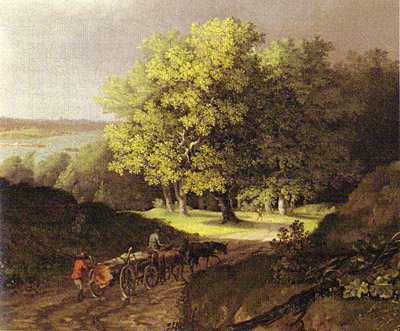
| | Den tidlige romantik tager afsæt i naturfølsom og patriotisme. En fædrelandskærlighed der dog ikke skelner imellem dansk,tysk, eller norsk indenfor den enevældige helstat.
Henimod slutningen af 1700-tallet udvikler Hellebæk på Sjællands nordkyst sig til en centrum for en ny tids åndelige strømninger. |
Romantik og patriotisme
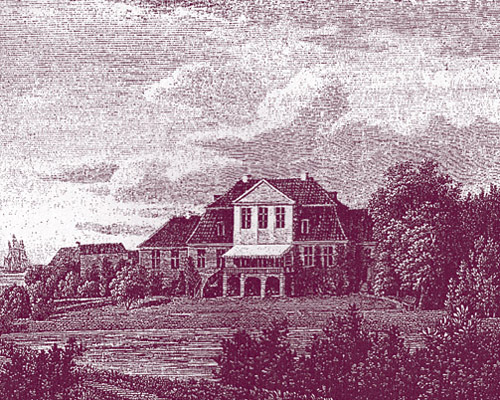
| | Den tidlige romantik i slutningen af 1700-tallet tager udgangspunkt i naturfølsomhed og patriotisme.
Geværfabrikanten Ernst Schimmelmann samlede en kreds af tidens åndspersoner omkring sig, bl.a. ved sammenkomster og besøg på Hellebækgård i Nordsjælland om sommeren. |
Henimod slutningen af 1700-tallet udvikledes Hellebæk sig til et centrum for en ny tids åndelige strømninger, romantikken. Den tidlige romantik tog udgangspunkt i naturfølsomhed og patriotisme, en fædrelandskærlighed der dog ikke skelnede imellem dansk, tysk eller norsk indenfor den enevældige, danske helstats grænser.
Hyldest til Hellebæk
Naturen omkring Hellebæk appellerede åbenlyst til den tidlige romantiske ånd i anden halvdel af 1700-tallet og den unge Ernst Schimmelmann, som omkring 1768 overtog ledelsen af geværfabrikken i Hellebæk på sin faders vegne, var levende interesseret i tidens naturfølsomme tankegang. Efter det første besøg på lokaliteten beskriver han i et brev til sin ven juristen August Hennings omgivelserne således:
"Jeg kommer i dag tilbage fra Helsingøer hvor jeg har tilbragt to Dage for at besee Geværfabriken, som ligger en halv Mils Vej paa den anden Side af denne By.
De kan ikke tænke Dem noget mere henrivende Sted. De forskjelligste, de meest romantiske Naturscener ere der forenede. Det ligger ved Bredden af Havet. der uophørligt er bedækket med Skibe; lige overfor ser man Sverigs Klipper. Søger De en ensom eller rolig Plet, behøver De blot at gaa ind i Skoven. som gjemmer en Rigdom af Søer; er De træt af disse, ville forskjeliige Bække oplive Dem med deres Rislen. Høie med bliide Skraaninger, dunkle og stille Dale - dog, min Kjære, jeg veed ikke, hvorledes jeg bærer mig ad; men jeg beskriver meget kummerligt det skiønneste Sted i Verden. See bort fra min Beskrivelse, og forestil Dem et fuldkomment henrivende Landskab: fortryllende om Sommeren og højtidsfuldt om Vinteren.
Alt dette er kun en Forberedelse; men mit projektrige Hoved har undfanget en Ide, nemlig den, at vi - hvis De kommer Elskværdigste - meget godt kunne sige Verden farvel for en Maaned eller længere og kaste os i Armene paa denne tiltrækkende Ensomhed…"
Friedrich Leopold, greve af Stolberg, skrev i 1776 et digt til "Hellebeck. Eine Seeländische Gegend". Friedrich Stolbergs far var overhofmester hos enkedronning Sofie Amalie på Hørsholm gods, hvor han medvirkede til at iværksætte de tidligste landboreformer omkring 1750.
Sønnen Friedrich studerede i Göttingen, hvor han kom i nærmere berøring med Klopstocks romantik. Sine tidlige år tilbragte han imidlertid i Danmark og det er Øresund han besynger i sine hymner til havet. Naturen er i centrum for hans lyrik, den betragtes som hellig og mennesket er i pagt med naturen. Det er universalromantik i tidlig klædning.

Ernst Schimmelmann 1747-1831 |
Samlingspunkt
Ernst Schimmelmann samlede en kreds af tidens åndspersoner omkring sig, bl.a. ved sammenkomster og besøg på Hellebækgård om sommeren. Blandt gæsterne var de romantiske digtere Friedrich Klopstock, Friedrich Stolberg, Jens Baggesen og Adam Oehlenschläger, filosoffen Heinrich Steffens og naturvidenskabsmanden H.C.Ørsted.
I denne tidlige fase af romantikken, førend nationalromantik og nationalfølelse for alvor sætter sig igennem, skelnede man indenfor helstaten ikke imellem tysk og dansk, eller for den sags skyld norsk, og betegnende herfor udkommer Jens Baggesens ode til Ernst Schimmelmann med titlen "Hellebecks Harpe" i tysk redaktion i 1801.

Jens Baggesen 1764 - 1826 | 
A. Oehlenschläger 1779-1850 | 
H.C. Ørsted 1777-1851 |
Folk og Fædreland
Romantikkens gennembrud i Danmark regnes ofte med Adam Oehlensclägers Digte 1803, som han skriver under påvirkning af filosoffen Heinrich Steffens, født i Norge, opvokset i Danmark og uddannet i Tyskland. Oehlenschläger blev skarp forfulgt af dansk-tyskeren Schack Staffelt født på Rügen, der udsendte Digte 1804, men allerede i 1793 havde leveret en romantisk hilsen til Øresund
Den intense naturdyrkelse er et karakteristisk træk ved den tidlige romantik, patriotismen et andet. Patriotisme betyder fædrelandskærlighed, men i første omgang ikke i nationalromantikkens snævre forstand, hvor en nation forbindes med begrebet folk i betydningen en gruppe mennesker, som har samme sprog, kultur og historie. Denne opfattelse tager form i tiden omkring den franske revolution, men endnu er mange af Europas lande, ligesom Danmark-Norge, multinationale samfund, der statsligt er knyttet sammen af en fælles fyrstemagt.
Ikke desto mindre var den nationale fællesskabsfølelse i anmarch og man begyndte også at få øje på folket. Dette havde også rod i oplysningstidens interesse for særegne befolkningsgrupper og deres levevis og gerninger. Denne interesse viser sig allerede i forbindelse med kong Christian d.6.s rejse til Norge i 1733 og siden hen med etableringen af Normandsdalen i Fredensborg Slotspark, hvor der blev opstillet en lang række statuer af mere eksotiske repræsentanter for kongeriget.

Heinrich Steffens |
Johannes Ewald
I den danske helstat havde man indtil videre hovedsagelig blik for heroiske og opofrende gerninger i fortid og nutid som kunne styrke og gavne samfundet og fællesskabsfølelsen. Et godt eksempel på en sådan begivenhed er en stranding på Nordsjælland kyst, nærmere betegnet Hornbæk, hvor lokale fiskere d. 9.11.1774 på heltemodig vis kastede sig ud i en redningsaktion.
Poeten Johannes Ewald bliver opfordret til at skildre begivenheden og skriver syngespillet "Fiskerne" som opføres i 1779. Herfra stammer nationalsangen, den såkaldte kongesang, "Kong Kristian". Tidligere konger og søheltes store patriotiske gerninger besynges og forbindes i skuespillet med den jævne mands opofrende og heltemodige optræden og hermed knyttes båndene imellem folk og regent.
Allerede i 1776 havde Ewald haft stor succes med en Ode til Indfødsretten. Loven om Indfødsretten bestemte at embeder i administrationen var forbeholdt personer der var født i helstaten. Dette skulle med andre ord styrke helstatspatriotismen og kom som en reaktion på den massive tyske indflydelse i Struenses regeringstid (1770-73). Johannes Ewald var i øvrigt var tæt knyttet til det nordsjællandske, han besang Rungsteds Lyksaligheder og hans Ode til Sjælen er forfattet i hans tid i Espergærde-Humlebæk.

Johannes Ewald 1743-1781 | 
Kongesangen |
Den romantiske Have
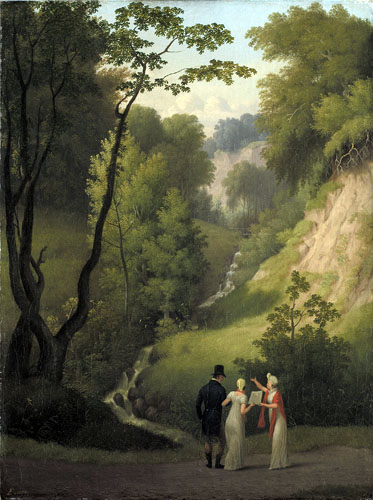
| | I slutningen af 1700-tallet blev en række af de kongelige haver omlagt fra barok stilen til den romantiske stil. Det drejede sig bl.a. om Frederiksberg have og Marienlyst slotshave ved Helsingør
Aristokratiet lod sig også inspirere af den nye havestil. Liselund på Møn er et godt eksempel på dette. |
En ny havetype
Så sent som i 1760erne anlagdes eller omlagdes både Fredensborg, Frederiksberg og Marienlyst haver til barokke haveanlæg i fransk stil med ustrakt orden og symmetri. Blot 30 år senere havde stilen skiftet til en mere landskabelig og oplevelsespræget have. Mens barokkens orden spejlede den kontinentale enevældes tid, så er den engelske, landskabelige have et varsel om nye tider.
Som den eneste af kongehusets slotshaver undgik barokhaven ved Frederiksborg Slot dog at blive omlagt til romantisk landskabshave. Det har formentlig været for vanskeligt og forbundet med store omkostninger at fælde de mange lindealléer og ændre det karakteristiske terrasseformede terræn.
I England fik man tidligt parlamentarisk styre med vægt på den enkeltes rettigheder og selvbestemmelse. Man skal selv kunne orientere sig i landskabet, også det politiske, og der åbnes op for en større, om man vil romantisk, følsomhed, som også er et varsel om en kommende tids borgerstyre.
Frederiksberg Have
En sammenligning af J.C. Kriegers tegning af Frederiksberg Have fra 1760 med Peter Petersens planskitse fra 1795 til en romantisk have samme sted åbenbarer med tydelighed forskellene imellem den barokke og den romantiske have. Mens barokhaven er præget af symmetri og regelmæssighed er det modsatte tilfældet med den romantiske planskitse: De centrale dele af haven er omdannet til et virvar af slyngede stier og vandsystemet er omskabt til et tilfældigt udseende bugtet forløb med tre søer.
Helt tilfældigt er det nu ikke. Alt er iscenesat, men det skal gerne ligne ”den rigtige” natur og den diffuse tilrettelæggelse lægger op til at den besøgende går på opdagelse i haven. Derfor er der også indlagt forskellige overraskelser: Et vandfald, et antikt tempel og den ene ø huser et kinesisk hus og en ditto gangbro. Disse momenter skal som sagt stimulere oplevelsen og stemme sindet følsomt. Frederiksberg Have er de senere år rekonstrueret som romantisk have, bl.a. er vandfaldet, som oprindelig var hestetrukket, genskabt.

Frederiksberg Have | 
Den romantiske have | 
Kongen i Frederiksberg Have. | 
Kinahuset | 
Kineserbroen |

Landskabshaven | 
Vandfaldet i Frederiksborg park |
Marienlysts romantiske have
Marienlyst ved Helsingør var i perioden 1759-64 blevet omskabt til et klassicistisk palæ og i 1667 forsynet med en barokhave i fransk stil. Officielt stod hofmarskal, greve A.G. Moltke som bygherre, men reelt var det kongen, Frederik 5.., der ejede foretagendet. Hans efterfølger Christian 7. benyttede slottet ved nogle enkelte officielle lejligheder, men det overgik snart til hans stedmoder enkedronning Juliane Marie, der lægger navn til det.
En planskitse af den tyske gartner Johan Ludvig Mansas fra omkring 1790 illustrer planerne for et nyt romantisk haveanlæg. I dette tilfælde er der tale om at bygge udenpå den eksisterende have, således at den dramatiske skrænt bagved det eksisterende kommer til som et supplerende anlæg. Det er en udpræget romantisk oplevelseshave som tilføjes eksotiske indslag såsom Hamlets grav og Ophelias kilde. Disse forsætter langt ind i 1800-tallet som seværdigheder for den voksende turistskare. På det seneste har der været tale om at genoprette dele af det romantiske anlæg.

Marienlyst romantiske have |
Liselund
Ikke kun de kongelige, men også formuende aristokrater fattede interesse for den nye havestil. Et eksempel herpå er ægteparret Antoine og Lisa de la Calmette, der skabte det romantiske anlæg omkring Liselund på Møn. Antoine var hollandsk diplomatsøn og ægteparret foretog flere gange dannelsesrejser til Sydeuropa, måske inspireret af englænderen Laurence Sterns beretning om den følsomme rejse til Italien og Frankrig.
Den umiddelbare inspiration kommer formodentlig fra Nordtyskland og i fra 1791 foreligger en planskitse af landskabsmåler M. Westenholdt. Denne indeholder bl.a. forslag til beplantninger med eg og bøg nøje afstemt med omgivelserne og de planlagte byggerier, som udover hovedbygningen Liselund bl.a. omfattede Det norske Hus, Schweizerhytten med tilhørende nåletræer og et kinesisk lysthus med hængeask. Nåletræer er noget forholdsvis nyt og eksotisk og i det hele taget anvendes mange sjældne træarter.

Liselund 1791 | 
Liselunds romantiske have. | 
Liselund | 
Interiør | 
Den romantiske Have |

Landskabshaven | 
Kløften | 
Liselunds Have |
Andre eksempler
Den romantiske have, landskabshaven, oplevelseshaven eller den engelske have bliver altså et modefænomen i slutningen af 1700-tallet. I nogle tilfælde omskabes eksisterende haver, som f.eks. Frederiksberg Have, helt eller delvist, mens i andre tilfælde helt nye romantiske haver anlægges af en række privatpersoner. Haveanlægget skal nu heller ikke blot repræsentere den enevældige statsmagt.
Udover Liselund kan nævnes Dronninggård, senere Næsseslottet, ved Furesøen nord for København, hvor mange velhavende borgerlige erhvervede lystejendomme i den såkaldte florissante periode i slutningen af 1700-tallet, hvor man i Danmark som neutralt land tjente store penge på international transithandel.Eksterne links til 1700-tallet

| | Linkikonet åbner for hjemmesider, hvor der kan findes yderligere oplysninger om 1700-tallet En del af disse tilbyder også en engelsk version eller resumé. |
|